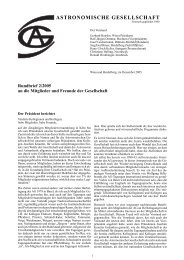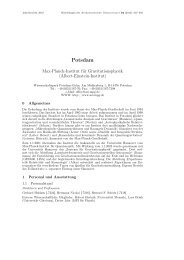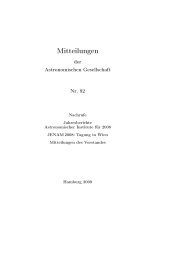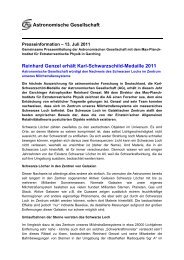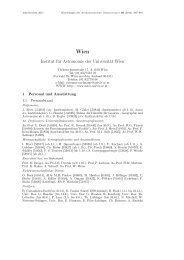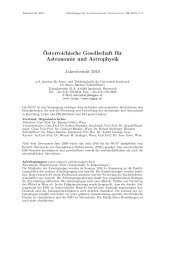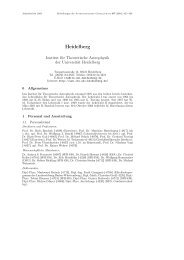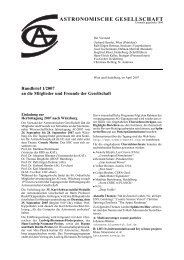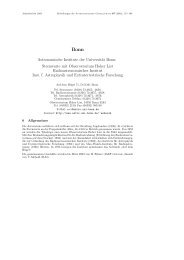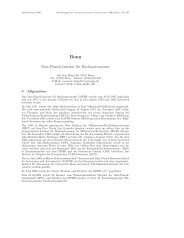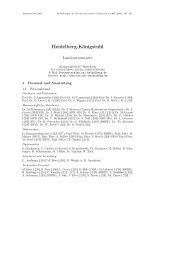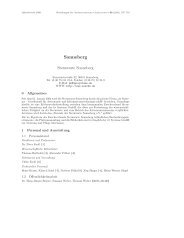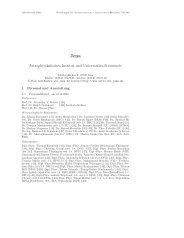Katlenburg-Lindau - Astronomische Gesellschaft
Katlenburg-Lindau - Astronomische Gesellschaft
Katlenburg-Lindau - Astronomische Gesellschaft
Erfolgreiche ePaper selbst erstellen
Machen Sie aus Ihren PDF Publikationen ein blätterbares Flipbook mit unserer einzigartigen Google optimierten e-Paper Software.
Jahresbericht 2003 Mitteilungen der <strong>Astronomische</strong>n <strong>Gesellschaft</strong> 87 (2004), 537–558<br />
<strong>Katlenburg</strong>-<strong>Lindau</strong><br />
Max-Planck-Institut für Aeronomie<br />
Max-Planck-Straße 2, 37191 <strong>Katlenburg</strong>-<strong>Lindau</strong><br />
Tel. (05556)979-0, Telefax: (05556)979-240<br />
E-Mail: solanki-office@linmpi.mpg.de; Internet: http://www.linmpi.mpg.de<br />
0 Allgemeines<br />
Gegenstand und Methoden der Forschung<br />
Die Erforschung des Sonnensystems steht im Mittelpunkt mit den zwei Hauptforschungsgebieten:<br />
Sonne und Heliosphäre einerseits und Planeten einschließlich ihrer Monde und<br />
kleiner Körper andererseits. Erforscht werden insbesondere die Atmosphäre der Sonne und<br />
das interplanetare Medium, Strahlung und energiereiche Teilchen von der Sonne, die kosmische<br />
Strahlung, das Innere, die Oberflächen, Atmosphären und Magnetosphären der<br />
Planeten, deren Ringe und Monde sowie Kometen und Asteroiden.<br />
In den Magnetosphären, im Sonnenwind und in der Umgebung von Kometen werden Teilchen<br />
und Wellen von Instrumenten auf Satelliten und Raumsonden in situ gemessen. Die<br />
Untersuchung der chemischen Zusammensetzung und räumlichen Verteilung der Teilchen<br />
und ihrer Verteilungsfunktionen im Geschwindigkeitsraum sowie das Studium von Transportvorgängen,<br />
Beschleunigungsprozessen, Rekonnektion, Turbulenz und Plasmainstabilitäten<br />
stehen dabei im Vordergrund.<br />
Die untere Atmosphäre der Sonne (Photosphäre und Chromosphäre) wird an Hand von<br />
spektropolarimetrischen Messungen sowohl vom Boden wie auch vom Weltraum aus untersucht.<br />
Dabei geht es vor allem um die Untersuchung des solaren Magnetfeldes, welches eine<br />
grundlegende Rolle für eine Vielzahl solarer Phänomene spielt. Die Korona der Sonne wird<br />
mit optischen Instrumenten im gesamten Spektralbereich vom Sichtbaren bis zum weichen<br />
Röntgenlicht vom Weltraum aus beobachtet, und ihre Plasmaeigenschaften werden mit<br />
spektroskopischen Methoden diagnostiziert.<br />
Eine Vielzahl von Bildern wird mit Instrumenten auf Raumsonden und der Erde (CCD-<br />
Kameras, Teleskope) gewonnen zur Erforschung der Sonne, der Kometen, der Planeten<br />
(insbesonders Mars) und deren Monde. Bei der überwiegend experimentell ausgerichteten<br />
Arbeitsweise des Instituts stehen Entwicklung und Bau von Instrumenten und Gewinnung<br />
und Auswertung von Meßdaten im Vordergrund. Diese Aktivitäten werden jedoch intensiv<br />
von theoretischen Arbeiten und der Bildung von physikalischen Modellen begleitet. Hier<br />
liegt das Hauptgewicht auf numerischen Simulationen.
538 <strong>Katlenburg</strong>-<strong>Lindau</strong>: Max-Planck-Institut für Aeronomie<br />
1 Personal und Ausstattung<br />
1.1 Personalstand<br />
Direktoren und Professoren:<br />
Direktoren: Prof. Dr. Ulrich Christensen [-467], Dr. Helmut Rosenbauer [-422], Prof. Dr.<br />
Sami K. Solanki [-325], Prof. Dr. Vytenis Vasyliunas [-299].<br />
Emeritierte Wissenschaftliche Mitglieder: Prof. Sir Ian Axford, FRS, Prof. Dr. Tor Hagfors.<br />
Auswärtige wissenschaftliche Mitglieder: Prof. Dr. Albert A. Galeev, Prof. Dr. Johannes<br />
Geiss, Prof. Dr. Karl-Heinz Glaßmeier, Prof. Dr. Erwin Schopper.<br />
Wissenschaftliche Mitarbeiter:<br />
Geschäftsführer: Dr. Peter Czechowsky (bis 30.06.), Dr. Iancu Pardowitz (ab 01.07.).<br />
Professoren und habil. Mitarbeiter: Dr. habil. Jörg Büchner, Prof. Dr. Wing-Huen Ip (bis<br />
31.07.), Prof. Dr. Klaus Jockers, Dr. habil. Horst Uwe Keller, Prof. Dr. Eckart Marsch,<br />
Prof. Dr. James F. McKenzie (bis 31.05.), Prof. Dr. Konrad Sauer, Prof. Dr. Manfred<br />
Schüssler, Prof. Dr. Rainer Schwenn, Prof. Dr. Peter Stubbe (bis 31.05.).<br />
Dr. Peter Barthol, Dr. Thomas Blümchen, Dr. Reinhard Borchers, Dr. Volker Bothmer,<br />
Dipl.-Phys. Peter Börner, Dr. Werner Curdt, Dr. Patrick W. Daly, Dipl.-Math. Ingolf Dammasch<br />
(bis 30.04.), Dr. Markus Fränz, Dr. Fred Goesmann, Dr. Björn Grieger, Dr. Paul<br />
Hartogh, Dipl.-Phys. Hermann Hartwig, Dr. Istvan Hejja (ab 01.08.), Dr. Martin Hilchenbach,<br />
Dr. Nico Hoekzema, Dr. Stubbe Hviid, Dr. Bernd Inhester, Dr. Christopher Jarchow,<br />
Dr. J. Kissel, Dr. Jürgen Klostermeyer, Dr. Andreas Kopp, Dr. Axel Korth, Dr. Jörg-Rainer<br />
Kramm, Dr. Natalia Krivova, Dr. Norbert Krupp, Dr. Michael Küppers (ab 01.02.), Dr.<br />
Andreas Lagg, Dr. Stefano Livi (bis 30.09.), Dr. Urs Mall, Dr. Wojcieck Markiewicz, Dr.<br />
Davina Markiewicz-Innes, Dr. Claudia-Veronika Meister, Dipl.-Phys. Andreas Nathues,<br />
Dr. Erling Nielsen, Dr. Bernd Nikutowski (ab 17.03.), Dr. Fabrice Portier-Fozzani (bis<br />
14.09.), Dr. Michael L. Richards, Dr. Arne K. Richter, Dr. Michael Rietveld (bis 31.12.),<br />
Dr. Reinhard Roll, Dr. Jon Rotvig (ab 01.12.), Dr. Dieter Schmitt (Research School), Dr.<br />
Udo Schühle, Dr. Joachim Segschneider (bis 01.08.), Dr. Holger Sierks, Dr. Nicolas Thomas<br />
(bis 28.02.), Dr. Dimitri Titov, Dr. Stefan Werner, Dr. Johannes Wicht (ab 01.04.) Dr.<br />
Thomas Wiegelmann, Dr. Manfred Witte (bis 28.02.), Dr. Bernd Wöbke (Gmelin Institut),<br />
Dr. Joachim Woch, Dr. Ursula Wüllner (ab 01.04.).<br />
Doktoranden:<br />
Siehe „Abgeschlossene“ und „Laufende“ Dissertationen<br />
Sekretariat und Verwaltung:<br />
Sekretariate der Direktoren: Sabine Deutsch, Susanne Kaufmann, Karin Peschke, Rosemarie<br />
Röttger, Barbara Wieser.<br />
Sekretariate: Anja Behrens, Gerlinde Bierwirth, Marita Eickemeier (bis 30.06.), Petra Fahlbusch,<br />
Elke Hartmann, Beatrix Hartung, Christiane Heise, Karin Kellner, Helga Oberländer,<br />
Karin Peschke, Helga Reuter, Sibylla Siebert-Rust, Ute Spilker, Sabine Stelzer, Margit<br />
Steinmetz, Andrea Vogt.<br />
Verwaltung: Andreas Poprawa (Leitung), Jürgen Bethe, Bernhard Bleckert (Altersteilzeit),<br />
Edith Deisel, Martina Heinemeier, Renate Heitkamp, Roswitha Komossa, Andrea Macke,<br />
Christiane Neu, Inge Reuter, Martina Schlemme (bis 31.03.), Dorothee Schreiber, Nadine<br />
Teichmann, Andrea Werner.<br />
Bibliothek: Inge Kraeter, Renate Meusel.<br />
Einkauf: Monika Majunke, Ilse Schwarz, Christina Thomitzek, Bernhard Vogt.
<strong>Katlenburg</strong>-<strong>Lindau</strong>: Max-Planck-Institut für Aeronomie 539<br />
Technisches Personal:<br />
Abteilung EDV (Leitung: Dr. Iancu Pardowitz): Andreas Blome, Bernhard Brauner (bis<br />
31.12.), Michael Bruns, Peter Fahlbusch, Lothar Graf, Terrence Ho, Dr. Georg Kettmann,<br />
Christine Ludwieg, Dipl.-Math. Helmut Michels, Godehard Monecke, Adolf Piepenbrink,<br />
Jürgen Wallbrecht.<br />
Dokumentation, Konstruktion: Wolfgang Engelhardt (Leitung bis 30.09.), Bernd Chares<br />
(Leitung ab 01.10.), Anita Brandt, Bernhard Goll (bis 30.09.), Angelika Hilz (ab 01.09.),<br />
Marianne Krause, Jürgen Wedekind (bis 31.03.), Mona Wedemeier.<br />
Laboratorien: Helmut Zapf (Leitung bis 16.05.), Dr. Iancu Pardowitz (Leitung ab 17.05.):<br />
Günther Auckthun, Walter Böker, Waltherus Boogaerts, Dipl.-Ing. Irene Büttner, Eberhard-<br />
Michael Clement, Dipl.-Ing. Arne Dannenberg, Werner Deutsch, Dipl.-Ing. Rainer Enge,<br />
Andreas Fischer, Dipl.-Ing. Henning Fischer, Dietmar Germerott, Klaus-Dieter Gräbig,<br />
Manfred Güll, Dipl.-Ing. Klaus Heerlein, Dipl.-Ing. Peter Hemmerich (bis 28.02.),<br />
Heinz Günter Kellner, Wolfgang Kühn, Wolfgang Kühne, Dipl.-Ing. Alexander Loose, Olaf<br />
Matuscheck, Dipl.-Ing. Reinhard Meller, Markus Monecke, Oliver Küchemann, Dipl.-Ing.<br />
Reinhard Müller, Wolfgang Neumann, Jürgen Nitsch, Dipl.-Ing. Henry Perplies, Dipl.-<br />
Ing. Borut Podlipnik, Klaus-Dieter Preschel, Waltraut Reich, Dipl.-Phys. Timo Riethmüller,<br />
Dipl.-Ing. Claudius Römer, Helmut Schild, Gustav-Adolf Schlemm (bis 30.11.),<br />
Helmut Schüddekopf, Dipl.-Phys. Ilse Sebastian, Dipl.-Ing. Hartmut Sommer, Dipl.-Ing.<br />
Li Song, Michael Sperling, Dipl.-Ing. Eckhard Steinmetz, Ulrich Strohmeyer, Dipl.-Ing.<br />
Istvan Szemerey, Dr. Hellmuth Timpl, Dipl.-Ing. Georg Tomasch, Thomas Tzscheetzsch,<br />
Daniel Windler, Wolfgang Wunderlich.<br />
Werkstätten, Haustechnik, Ausbildung: Dipl.-Ing. Volker Thiel (Leitung), Feinmechanik:<br />
Egon Pinnecke, Hermann Arnemann, Hans-Joachim Gebhardt, Ernst-Reinhold Heinrichs,<br />
Dietmar Hennecke, Detlef Jünemann, Roland Mende, Norbert Meyer, Werner Steinberg.<br />
Schlosserei: Hans-Joachim Heinemeier. Galvanik-Siebdruck: Hans-Adolf Heinrichs, Mathias<br />
Schwarz, Walter Wächter. Haustechnik: Horst Heise, Michael Hilz, Peter Mutio, Mario<br />
Reich, Mario Strecker, Karl-Heinrich Deisel, Herbert Ellendorff, Werner Hundertmark,<br />
Helge Aue, Martin Heinrich, Martin Schröter, Rober Uhde, Hans-Dieter Waitz.<br />
1.2 Instrumente und Rechenanlagen<br />
Das Institut verfügt über ein Rechenzentrum mittlerer Größe, welches UNIX-Rechner<br />
(SUN, COMPAQ und zahlreiche PCs) im wesentlichen zur Auswertung von Satelliten-<br />
Daten benutzt.<br />
1.3 Gebäude und Bibliothek<br />
In unserer Bibliothek werden 122 laufende Zeitschriften geführt.<br />
2 Gäste<br />
Eine Liste der Gäste befindet sich im Jahresbericht des Max-Planck-Instituts für Aeronomie,<br />
welcher alle 2 Jahre erscheint.<br />
Siehehttp://www.linmpi.mpg.de/publikationen/taetigkeitsbericht 2002+2003.pdf<br />
2.1 Lehrtätigkeiten<br />
Siehe Jahresbericht des Max-Planck-Instituts für Aeronomie, welcher alle 2 Jahre erscheint.<br />
Siehehttp://www.linmpi.mpg.de/publikationen/taetigkeitsbericht 2002+2003.pdf<br />
2.2 Gremientätigkeit<br />
Siehe Jahresbericht des Max-Planck-Instituts für Aeronomie, welcher alle 2 Jahre erscheint.<br />
Siehehttp://www.linmpi.mpg.de/publikationen/taetigkeitsbericht 2002+2003.pdf
540 <strong>Katlenburg</strong>-<strong>Lindau</strong>: Max-Planck-Institut für Aeronomie<br />
3 Wissenschaftliche Arbeiten<br />
Anstelle einer detaillierten Übersicht werden ein paar Glanzlichter präsentiert.<br />
3.1 SMART-1 – Europas Mission zum Mond<br />
3.1.1 Die Erforschung des Mondes und die Ziele der SMART-1 Mission<br />
Seit am 14. Dezember 1972 die Besatzung der Apollo 17 Mission das Taurus Littrow Tal am<br />
südöstlichen Rand des Mare Serenitatis mit dem Ziel Erde verließ, hat die Menschheit die<br />
Mondoberfläche nicht mehr betreten. Nach über 30 Jahren wird nun eine neue Initiative für<br />
eine weitere Phase der Erforschung und der Nutzung des Mondes in den USA eingeläutet.<br />
In den letzten Jahren haben jedoch einige Nationen bereits wieder angefangen, mittels satellitengestützter<br />
Fernerkundung offene Fragen der Mondforschung anzugehen. Unter den<br />
zur Zeit laufenden Missionen wird die europäische Mission SMART-1 (Small Missions for<br />
Advanced Research in Technology) als nächste den Mond erreichen. Obwohl SMART Missionen<br />
eigentlich Technologien entwickeln sollen, die dann bei den großen Europäischen<br />
Cornerstone Missionen zum Einsatz kommen sollen, will die Europäische Weltraumorganisation<br />
ESA mit der SMART-1-Mission auch noch ein altes Versprechen einlösen, nämlich<br />
einen europäischen Beitrag zur weiteren Erforschung des Mondes zu leisten.<br />
Man kann sich an dieser Stelle fragen, warum der Mond, den die Menschheit als einzigen<br />
Himmelskörper direkt besucht hat und von dem über 380 kg Gesteinsproben in irdischen<br />
Labors minutiös untersucht wurden, immer noch wissenschaftliches Interesse findet.<br />
Das Interesse am Mond beruht unter anderem auf folgenden Tatsachen: Verglichen mit<br />
den terrestrischen Planeten ist der Mond einzigartig was seine Größe, Dichte und seinen<br />
Ursprung angeht. Die Bildung des Erd-Mond-Systems muß nach wie vor als eine offene<br />
Frage betrachtet werden. Von den zur Auswahl stehenden Theorien scheint nur die Einschlagstheorie<br />
akzeptabel zu sein, die im wesentlichen besagt, daß die Erde mit einem sehr<br />
großen Objekt (in etwa von der Größe des Mars) kollidierte, und daß der Mond aus dem dabei<br />
herausgeschlagenen Material besteht. Die starke Präferenz für diese Theorie muß aber<br />
vor dem Hintergrund gesehen werden, daß all die anderen Theorien zu viele unplausible<br />
Annahmen machen müssen. Um diese Fragestellung klar beantworten zu können, müssen<br />
wir zwangsläufig mehr über die innere Struktur, die chemische Zusammensetzung und den<br />
Wärmefluß des Mondes wissen.<br />
Der Mond unterlag wie alle terrestrischen Planeten im Laufe seiner Geschichte einem<br />
Abkühlungs- und Entgasungsprozeß. In Planeten lassen radioaktive und andere Prozesse<br />
im Inneren Wärme entstehen, die dann nach außen abgeführt wird. Im Gesteins-Mantel<br />
erfolgt der Wärmetransport durch Wärmeleitung und Konvektion. Diese Prozesse laufen<br />
bei den verschiedenen Planeten ganz unterschiedlich ab. Bei der Erde zum Beispiel erfolgt<br />
der Wärmefluß an der Oberfläche zu 65 % durch Produktion, Migration und Subduktion<br />
lithosphärischer Platten, zu 20 % durch Wärmeleitung und zu 15 % durch den Zerfall<br />
radioaktiver Elemente in der Kruste, während beim Mond gar keine Plattenbewegung vorliegt.<br />
Gerade das Fehlen einer Plattentektonik und die Tatsache, daß wir für den Mond<br />
ein einzigartiges Datenarchiv haben, was die Geologie, Geochemie, Mineralogie, Petrologie<br />
und die Chronologie angeht, welches in seinem Umfang nur noch mit dem uns für die Erde<br />
vorliegenden vergleichbar ist, gibt dem Mond eine Sonderstellung in der vergleichenden<br />
Planetologie. Die Ein-Platten-Tektonik macht den Mond nämlich zu einem relativ einfach<br />
strukturierten Planeten. Es besteht deshalb die Hoffnung, daß wir beim Mond Einsichten in<br />
die Zusammenhänge zwischen geologischer Evolution und der internen sowie thermischen<br />
Entwicklung eines Planeten gewinnen können, die zu unserem generellen Verständnis der<br />
Entwicklung von Planeten beitragen.<br />
Die Hoffnung eines Europäischen Beitrages zum Studium dieser Fragen liegt nun auf der<br />
am 28. September 2003 mit einer Ariane 5 gestartete SMART-1 Mission, deren primäres<br />
technologisches Ziel es ist, eine mit einem Ionen-Antrieb ausgestattete Raumsonde auf einer<br />
16 Monate währenden Flugphase zum Mond zu testen. Die Raumsonde trägt eine aus 6
<strong>Katlenburg</strong>-<strong>Lindau</strong>: Max-Planck-Institut für Aeronomie 541<br />
Instrumenten bestehende Nutzlast, die 10 verschiedene wissenschaftliche und technische<br />
Experimente umfaßt.<br />
3.1.2 Der wissenschaftliche Beitrag des MPI für Aeronomie zu SMART-1<br />
Weil es wie bei der Erde auch beim Mond möglich ist, die Zusammensetzung des Mondinneren<br />
und damit die Zusammensetzung des Silikatanteils des Mondes aus bestimmten<br />
Mineralien an der Mondoberfläche abzuschätzen, zählt die Bestimmung der chemischen Zusammensetzung<br />
der Mondoberfläche zu den wichtigsten Aufgabenstellungen in der Mondforschung.<br />
An Bord der Raumsonde SMART-1 befindet sich daher eine Kamera, ein im<br />
Röntgenbereich empfindliches Spektrometer und ein vom Max-Planck-Institut für Aeronomie<br />
(MPAe) in <strong>Katlenburg</strong>-<strong>Lindau</strong> entwickeltes Spektrometer für das nahe Infrarot.<br />
Während spektroskopische Meßmethoden von Gesteinen generell geeignet sind, um Mineralien<br />
zu identifizieren, zählt die Nahinfrarotspektroskopie zu den besonders geeigneten<br />
Methoden, um die Oberflächenzusammensetzung von Planeten und kleinen Körpern zu<br />
bestimmen. Das vom MPAe gebaute SMART-1 Infrarot-Spektrometer (SIR) mißt das von<br />
der Sonne an einzelnen Mineralien reflektierte Licht in einem Wellenlängenbereich von 0.9–<br />
2.4 µm. Da einzelne Mineralien das Licht in diesem Bereich an ganz spezifischen Stellen<br />
absorbieren, kann man an Hand von einem Reflexionsspektrum aus der Lage und Stärke<br />
der Absorptionen im Spektrum einzelne Mineralien identifizieren.<br />
Von der Erde aus wurden natürlich schon Infrarot-Beobachtungen des Mondes vorgenommen.<br />
Doch solche Messungen haben zwei Nachteile. Erstens beschränken sich diese Messungen<br />
auf die der Erde zugewandten Mondseite und zweitens werden diese Messungen<br />
durch die Atmosphäre der Erde gestört. Messungen, die aus einer Mondumlaufbahn gemacht<br />
werden, haben dagegen den Vorteil, daß erstens der ganze vom Instrument meßbare<br />
Infrarotbereich ungestört von dem Einfluß der Atmosphäre aufgezeichnet und zweitens<br />
auch die Rückseite des Mondes analysiert werden kann. Dort befindet sich auch das nahe<br />
dem Südpol des Mondes gelegene Aitken Basin, ein Kratergebiet, das wegen seiner gewaltigen<br />
Ausmaße als größter bekannter Krater im Sonnensystem gilt. Bei einem Durchmesser<br />
von 2500 km und einer Tiefe von 13 km wird erwartet, daß an dieser Stelle Material aus<br />
dem Mondmantel sichtbar wird. Im Vorfeld für künftige Mondmissionen erwarten wir, daß<br />
SIR eine wichtige Rolle bei der Untersuchung dieses Gebietes leisten wird. Neben der Untersuchung<br />
von bisher kaum studierten Gebieten werden ferner bei Messungen, die aus<br />
einer Mondumlaufbahn gemacht werden, auch die räumliche Auflösung durch die Mondnähe<br />
verbessert. In der Tat ist SIR nicht das erste Infrarot-Spektrometer, das den Mond<br />
untersucht. Während frühere Spektrometer das Spektrum nur an einzelnen Stellen mittels<br />
Filtern abtasten konnten, mißt das neue Instrument den ganzen Spektralbereich durchgängig<br />
zwischen 0.9 und 2.4 µm. Aus diesem Grund und wegen seiner guten spektralen<br />
Auflösung von 6 nm hat SIR grundsätzlich auch die Möglichkeit, das viel diskutierte Eis<br />
auf dem Mond nachzuweisen, sofern es wirklich vorhanden ist.<br />
Daß das Wasser für die Entstehung von Leben wie wir es kennen eine unabdingbare Voraussetzung<br />
ist, bedarf keiner besonderen Erläuterung. Daß Wasser aber im Falle des Mondes<br />
zu einem Thema wurde, verdankt es einer Arbeit von Kenneth Watson und Kollegen, die<br />
1961 bemerkten, daß die äquatoriale Ebene des Mondes nur um 1.5 Grad zur Ekliptik<br />
geneigt ist und deshalb Krater, die in den Polgebieten liegen, im Innern Gebiete aufweisen,<br />
die ständig im Schatten liegen. Wegen der extrem niedrigen Temperaturen von ca. –200<br />
Grad Celsius in diesen Schattengebieten sollte dort das Wasser, sofern es einmal welches<br />
gab, noch als Eis vorliegen. Ob überhaupt Eis vorhanden ist und mittels welcher Mechanismen<br />
Wasser an diese Stellen überhaupt kommen konnte, steht nun seit geraumer Zeit<br />
im Zentrum des wissenschaftlichen Interesses und der Diskussion.<br />
Seit die Raumsonde Lunar Prospector den Mond im Jahre 1998 besucht hat, verfechten<br />
einige Wissenschaftler die These, daß kein Zweifel daran bestehe, daß sie Eis mittels eines<br />
Neutronenmonitors wirklich beobachtet hätten. Trifft nämlich die kosmische Strahlung<br />
auf die Mondoberfläche, so werden Neutronen aus der Mondoberfläche, dem Regolith,<br />
geschlagen, die in weiteren Kollisionen mit den Atomen des Mondgesteines zunehmend
542 <strong>Katlenburg</strong>-<strong>Lindau</strong>: Max-Planck-Institut für Aeronomie<br />
Energie verlieren. Infolge dieser Kollisionen werden solche mehr oder minder moderierten<br />
Neutronen auch in den Raum oberhalb der Mondoberfläche gestreut, wo sie von einem<br />
auf einem Satelliten sich befindlichen Neutronenmonitor auch registriert werden können.<br />
Treffen die Neutronen auf Stoßpartner, die fast die gleiche Masse wie sie selber haben, zum<br />
Beispiel Wasserstoff, dann können sie in diesen Stößen besonders viel Energie abgeben. Aus<br />
der Messung eines Neutronenspektrums kann also auf die atomaren Stoßpartner oder auf<br />
das makroskopische Material geschlossen werden, auf das die Neutronen treffen.<br />
In der Tat zeigt die Analyse der Lunar Prospector Messungen, daß es an den Polen besonders<br />
viel wasserstoffhaltiges Material zu geben scheint. Die Tatsache, daß dieses Material<br />
nun gerade in den Kratern, die im Schatten liegen, besonders konzentriert zu sein<br />
scheint, ist der wesentliche Punkt der Argumentation. Verglichen mit der Methode der<br />
Neutronenstreuung hat nun die Beobachtung von Eis mittels des Nahen Infrarotes einen<br />
besonders interessanten Aspekt. Während die Neutronenstreuung zwangsmäßig eine dicke<br />
Regolith-Schicht untersucht, beobachtet man mittels des Infraroten, da es sich um Reflexionsspektroskopie<br />
handelt, nur gerade die oberste Schicht. Da sich Eis, wegen seiner<br />
besonders schön ausgeprägten Absorptionsspektren im Infraroten, dort besonders leicht<br />
identifizieren läßt, würden erfolgreiche SMART-1-Beobachtungen sehr direkt und ohne<br />
weitere Annahmen beweisen, daß die von der Sonde überflogenen Oberflächen wirklich aus<br />
Eis bestehen. Im Hinblick auf die nun beschlossene Initiative, eine permanente bemannte<br />
Mondbasis zu errichten, erhält die Suche nach Wasser eine ganz neue Dimension. (Mall)<br />
3.2 International Max Planck Research School (IMPRS)<br />
on Physical Processes in the Solar System and Beyond<br />
at the Universities of Braunschweig and Göttingen<br />
Die „International Max Planck Research School on Physical Processes in the Solar System<br />
and Beyond at the Universities of Braunschweig and Göttingen“ ist eine gemeinsame<br />
Inititative des Max-Planck-Instituts für Aeronomie in <strong>Katlenburg</strong>-<strong>Lindau</strong> und der<br />
physikalischen Fakultäten der Universität Göttingen (Universitäts-Sternwarte, Institut für<br />
Geophysik) und der Technischen Universität Braunschweig (Institut für Geophysik und<br />
Meteorologie, Institut für Theoretische Physik). Sie bietet in- und ausländischen Studenten<br />
Gelegenheiten, auf dem Gebiet der Physik des Sonnensystems zu promovieren.<br />
Die Schule bietet ein forschungsintensives dreijähriges Promotionsstudium. Voraussetzung<br />
ist ein Diplom oder ein Master of Science in Physik. Die Abschlüsse (PhD oder Dr. rer.<br />
nat.) können an den beteiligten Universitäten Braunschweig und Göttingen oder an der<br />
Heimatuniversität angestrebt werden.<br />
Das Lehrprogramm beinhaltet die gesamte Physik des Sonnensystems von der Geophysik<br />
über Planetenphysik zur Sonnenphysik. Es garantiert eine breite, interdisziplinäre und fundierte<br />
wissenschaftliche Ausbildung. Das wissenschaftliche Programm wird durch Kurse in<br />
numerischer Physik, Weltraumtechnologie und Projektmanagement ergänzt. Das Lehrangebot<br />
ist in englischer Sprache.<br />
Die Forschungsmöglichkeiten für Doktoranden reichen von Instrumentierung und Beobachtung<br />
über Datenanalyse und -interpretation zu numerischen Simulationen und theoretischer<br />
Modellierung. Eine klare wissenschaftliche Schwerpunktbildung sorgt für eine<br />
thematische Verzahnung der einzelnen Promotionen. Durch die Bearbeitung gemeinsamer<br />
Themen und die enge Zusammenarbeit der Doktoranden in Forscherteams entsteht ein<br />
wissenschaftlicher Mehrwert.<br />
Im Jahr 2003 nahmen 49 Doktoranden an der Schule teil, davon haben 10 neu mit ihren<br />
Doktorarbeiten begonnen, und 5 haben ihre Promotionen erfolgreich abgeschlossen. Die<br />
Teilnehmer kommen aus insgesamt 16 Ländern, 65 % sind ausländischer Nationalität, 39 %<br />
sind weiblich.
<strong>Katlenburg</strong>-<strong>Lindau</strong>: Max-Planck-Institut für Aeronomie 543<br />
Vorstand:<br />
U. Christensen (MPAe), K.-H. Glassmeier (Technische Universität Braunschweig), F. Kneer<br />
(Universität Göttingen), U. Motschmann (Technische Universität Braunschweig), S. K. Solanki<br />
(MPAe, Vorsitz) A. Tilgner (Universität Göttingen)<br />
Koordinator: D. Schmitt (MPAe) (Schmitt)<br />
4 Diplomarbeiten, Dissertationen, Habilitationen<br />
4.1 Dissertationen<br />
Abgeschlossen:<br />
Katja Janßen: Struktur und Dynamik kleinskaliger Magnetfelder der Sonnenatmosphäre,<br />
Universitäts-Sternwarte, Universität Göttingen, 2003.<br />
Santo Valentin Salinas Cortijo: Multi-dimensional Polarized Radiative Transfer Modeling<br />
of Titan’s Atmosphere, Universität Göttingen, 2003.<br />
Alexander Vögler: Three-dimensional simulations of magneto-convection in the solar atmosphere,<br />
Universität Göttingen, 2003.<br />
Maren Wunnenberg: Untersuchung kurzperiodischer akustischer Wellen in der Sonnenatmosphäre<br />
mit Hilfe der Wavelet-Transformation, Universitäts-Sternwarte, Universität<br />
Göttingen, 2003.<br />
Lidong Xia: Equatorial Coronal Holes and Their Relation to the High-Speed Solar Wind<br />
Streams, Universität Göttingen, 2003.<br />
Nachtrag:<br />
Peter Vollmöller: Untersuchung der Wechselwirkung von Magnetfeldkonzentrationen und<br />
konvektiven Strömungen mit dem Strahlungsfeld in der Photosphäre der Sonne, Universität<br />
Göttingen (2002)<br />
Laufend:<br />
• IMPRS 2003, Max-Planck-Institut für Aeronomie:<br />
Ingo Jens Baumann: Simulation of magnetic flux transport on the Sun (Solanki/Schüssler).<br />
Juan Manuel Borrero Santiago: Inversion of the Stokes profile (Solanki).<br />
Monika Buske: Evolution models of the Martian interior (Christensen).<br />
Mark Cheung: Numerical simulation of magnetoconvection (Schüssler).<br />
Kerstin Cierpka: Auswertung von Fabry-Perot Daten zur Dynamik der Thermosphäre,<br />
Universität Göttingen (Schlegel).<br />
Maria Hebe Cremades Fernandez: Magnetic field configurations in coronal mass ejections<br />
(Bothmer/Schwenn).<br />
Yevgen Grynko: Reflection of light from atmosphereless solar system bodies and from<br />
cometary dust (Jockers).<br />
Michael Heuer: Kinetic plasma processes in the solar corona and solar wind (Marsch).<br />
Tra-Mi Ho: Data analysis and model calculations of cometary comae (Thomas/Keller).<br />
Carsten Köllein: Numerical simulations of the structure of cometary nuclei (Thomas/Keller).<br />
Fedor Kolesnikov: Vortex flows around magnetic flux tubes (Schüssler).<br />
Maxim Kramar: Tomography of coronal magnetic fields (Inhester/Marsch).<br />
Elena Kronberg: Dynamical processes in Jupiter’s magnetosphere (Woch/Krupp).<br />
Rupali Mahajan: Modeling of the Martian climate (Grieger/Keller).
544 <strong>Katlenburg</strong>-<strong>Lindau</strong>: Max-Planck-Institut für Aeronomie<br />
Marilena Mierla: Dynamics of the solar corona (Schwenn).<br />
Guadalupe Munoz Martinez: Coronal mass ejection acceleration, statistical and analytical<br />
evaluations (Schwenn).<br />
Ganna Portyankina: Atmosphere-surface vapour exchange and ices in the Martian polar<br />
regions (Markievicz/Keller).<br />
Sabine Preusse: Computer modeling of plasma interactions in extrasolar planetary systems<br />
(Büchner/ Motschmann).<br />
Aikaterini Radioti: Plasma composition in the magnetosphere of Jupiter (Woch/Krupp).<br />
Luciano Rodriguez Romboli: The heliosphere – Ulysses investigations (Woch/Krupp).<br />
Ryu Saito: Development of a general circulation model for Titan’s atmosphere (Hartogh).<br />
Martin Schrinner: Modeling of the geodynamo (Christensen/Schmitt).<br />
Andrey Seleznyov: The origin of solar variability, with an application to the search for<br />
extra-solar planets (Solanki).<br />
Alina Semenova: Modelling of giant starspots on the poles of rapidly rotating stars (Solanki).<br />
Sergey Shelyag: Simulations of solar magnetoconvection and their interpretation (Schüssler,<br />
Solanki).<br />
Ilya Silin: Theory and simulation of kinetic plasma instabilities (Büchner).<br />
Ana Teresa Monteiro Tomas: Planetary magnetospheres – Jupiter (Woch/Krupp).<br />
Denise Tortorella: Compressible convection in gas giant planets (Christensen).<br />
Durgesh Kumar Tripathi: Development of stereoscopic image processing methods for the<br />
STEREO mission (Bothmer/Schwenn).<br />
Geronimo Villanueva: Radiometry of ocone and water vapor in the Earth atmosphere<br />
(Hartogh).<br />
Vasily Zakharov: Investigation of phase diversity methods for the Sunrise project (Gandorfer,<br />
Solanki).<br />
• IMPRS 2003, Universität Göttingen:<br />
Aleksandra Andjic: Waves in the solar atmosphere observed with high spatial and temporal<br />
resolution (Kneer).<br />
Nazaret Bello Gonzalez: Magnetic fields in sunspots penumbrae (Kneer).<br />
Itahiza Francisco Dominguez Cerdena: Quiet Sun magnetic fields (Kneer).<br />
Oleg Okunev: Polar faculae of the Sun (Kneer).<br />
Markus Sailer: High spatial resolution for solar observations with Multi Conjugated Adaptive<br />
Optics and Speckle reconstruction (Kneer).<br />
Aveek Sarkar: Lattice-Boltzmann method applied to the dynamo problem (Tilgner).<br />
• IMPRS 2003, Technische Universität Braunschweig:<br />
Thorsten Bagdonat: Simulation of the solar wind interaction with comets (Motschmann).<br />
Dragos Ovidiu Constantinescu: Magnetic mirror structures in the terrestrial magnetosphere<br />
(Glassmeier).<br />
Jean-Mathias Grießmeier: Magnetospheres of extra-solar planets (Motschmann).<br />
Yasuhito Narita: Magnetospheric physics – Cluster II data analysis (Glassmeier).<br />
Michael Rost: Coagulation of magnetized dust in the early solar system (Glassmeier).<br />
Anja Stadelmann: Studies on paleomagnetospheric processes (Glassmeier).
<strong>Katlenburg</strong>-<strong>Lindau</strong>: Max-Planck-Institut für Aeronomie 545<br />
Jens Stadelmann: Diffusion of the geomagnetic secular variation through the heterogenuous<br />
mantle (Weidelt).<br />
5 Tagungen, Projekte am Institut und Beobachtungszeiten<br />
5.1 Tagungen und Veranstaltungen<br />
Siehe http://www.linmpi.mpg.de/<br />
5.2 Projekte und Kooperationen mit anderen Instituten<br />
Siehe Jahresbericht des Max-Planck-Instituts für Aeronomie, welcher alle 2 Jahre erscheint.<br />
Siehe<br />
http://www.linmpi.mpg.de/publikationen/taetigkeitsbericht 2002+2003.pdf<br />
5.3 Vorträge und Gastaufenthalte<br />
Siehe Jahresbericht des Max-Planck-Instituts für Aeronomie, welcher alle 2 Jahre erscheint.<br />
Siehehttp://www.linmpi.mpg.de/publikationen/taetigkeitsbericht 2003+2003.pdf<br />
5.4 Kooperationen<br />
Siehe Jahresbericht des Max-Planck-Instituts für Aeronomie, welcher alle 2 Jahre erscheint.<br />
Siehehttp://www.linmpi.mpg.de/publikationen/taetigkeitsbericht 2003+2003.pdf<br />
6 Veröffentlichungen<br />
6.1 In Zeitschriften und Büchern<br />
Armand, N.A., Smirnov, V.M., Hagfors, T.: Distortion of radar pulses by the Martian<br />
ionosphere. Radio Sci. 38 (2003), 1090. doi: 10.1029/2002RS002849<br />
Auth, C., Bercovici, D., Christensen, U.R.: Two-dimensional convection with a self-lubricating,<br />
simple-damage rheology. Geophys. J. Int. 154 (2003), 783–800<br />
Balmaceda, L., Lago, A.D., Stenborg, G., Francile, C., Gonzales, W.D., Schwenn, R.: Continuous<br />
tracking of CMEs using MICA, and LASCO C2 and C3 coronagraphs. Adv.<br />
Space Res. 32 (2003), 2625–2630<br />
Baumgärtel, K., Sauer, K., Dubinin, E.: Towards understanding magnetic holes: Hybrid<br />
simulations. Geophys. Res. Lett. 14 (2003), 1761. doi: 10.1029/2003GRL017373<br />
Belova, E., Chilson, P.B., Kirkwood, S., Rietveld, M.T.: The response time of PMSE to<br />
ionospheric heating. J. Geophys. Res. 108 (2003), 8446. doi: 10.1029/2002JD002385<br />
Borisov, N., Mall, U.: Interaction of the solar wind with a localized magnetic barrier:<br />
application to lunar surface magnetic fields. Phys. Lett. A 309 (2003), 277–289<br />
Borrero, J.M., Bellot Rubio, L.R., Barklem, P.S., Del Toro Iniesta, J.C.: Accurate atomic<br />
parameters for near-infrared spectral lines. Astron. Astrophys. 404 (2003), 749–762<br />
Brkovic, A., Peter, H., Solanki, S.K.: Variability of EUV-spectra form the quiet upper solar<br />
atmosphere: Intensity and Doppler shift. Astron. Astrophys. 403 (2003), 725–730<br />
Brynildsen, N., Maltby, P., Kjeldseth-Moe, O., Wilhelm, K.: Oscillations in the wings of<br />
sunspot transition region lines. Astron. Astrophys. 398 (2003), L15–L18<br />
Büchner, J., Dum, C.T., Scholer, M.: Space plasma simulation. In: Büchner, J., Dum, C.T.,<br />
Scholer, M. (eds.): Space Plasma Simulation. Lect. Not. Phys. (2003), 1–3<br />
Büchner, J., Mjolhus, E., Tsurutani, B.: Nonlinear Waves and Chaos in Space Plasmas.<br />
Nonlin. Proc. Geophys. 10 (2003), 1<br />
Büchner, J., Pevtsov, A.: Magnetic Helicity. Adv. Space Res. 32 (2003), 1817
546 <strong>Katlenburg</strong>-<strong>Lindau</strong>: Max-Planck-Institut für Aeronomie<br />
Büchner, J., Pevtsov, A.: Magnetic helicity at the Sun, in solar wind and magnetospheres<br />
– vistas from X-Ray Observatories. Elsevier (2003)<br />
Carcedo, L., Brown, D.S., Hood, A.W., Neukirch, T., Wiegelmann, T.: A quantitative<br />
method to optimise magnetic field line fitting of observed coronal loops. Solar Phys.<br />
218 (2003), 29–40<br />
Christensen, U.R., Olson, P.: Secular variation in numerical geodynamo models with lateral<br />
variations of boundary heat flow. Phys. Earth Planetary Inter. 138 (2003), 39–54<br />
Cierpka, K., Kosch, M.J., Holma, H., Kavanagh, A.J., Hagfors, T.: Novel Fabry-Perot<br />
interferometer measurements of F-region ion temperature. Geophys. Res. Lett. 30<br />
(2003), 1293. doi: 10.1029/2002GL015833<br />
Curdt, W.: Solar observations from space and from the ground. Astron. Nachr. 324, 4<br />
(2003), 334–337<br />
Curdt, W., Wang, T.J., Dammasch, I.E., Solanki, S.K.: Doppler oscillations of active region<br />
loops: steps towards coronal seismology. Hvar Obs. Bull. 27 (2003), 83–90<br />
Dal Lago, A., Schwenn, R., Gonzalez, W.D.: Relation between the radial speed and the<br />
expansion speed of coronal mass ejections. Adv. Space Res. 32 (2003), 2637–2640<br />
Dal Lago, A., Schwenn, R., Stenborg, G., Gonzalez, W.D.: Coronal mass ejection speeds<br />
measured in the solar corona using LASCO C2 and C3 images. Adv. Space Res. 32<br />
(2003), 2619–2624<br />
Dubinin, E., Sauer, K., McKenzie, J.F.: Nonlinear stationary whistler waves and whistler<br />
solitons (oscillitons): Exact solutions. J. Plasma Phys. 69 (2003), 305–330<br />
Dubinin, E., Sauer, K., McKenzie, J.F., Chanteur, G.: Solitons, oscillitons and stationary<br />
waves in a cold p-α plasma. J. Geophys. Res. 107 (2003), 1295.<br />
doi: 10.1029/2002JA009571<br />
Dubinin, E., Sauer, K., McKenzie, J.F., Chanteur, G.: Solitons, oscillitons and stationary<br />
waves in a warm p-α plasma. J. Geophys. Res. 107 (2003), 1296.<br />
doi: 10.1029/2002JA009572<br />
Dwivedi, B.N., Mohan, A., Wilhelm, K.: Diagnosing the solar atmosphere from vacuum<br />
ultraviolet (VUV) observations. In: Dwivedi, B.N. (ed.): Dynamic Sun. Cambridge:<br />
Cambridge University Press (2003), 353–373<br />
Espinosa, S.A., Southwood, D.J., Dougherty, M.K.: How can Saturn impose its rotation<br />
period in an noncorotating magnetosphere? J. Geophys. Res. 108 (2003), 1086. doi:<br />
10.1029/2001JA005084<br />
Espinosa, S.A., Southwood, D.J., Dougherty, M.K.: Reanalysis of Saturn’s magnetospheric<br />
field data view of spin-periodic perturbations. J. Geophys. Res. 108 (2003), 1085. doi:<br />
10.1029/2001JA005083<br />
Feldman, U., Landi, E., Curdt, W.: Nonthermal mass motions within the high-temperature<br />
plasmas above a complex solar active region. Astrophys. J. 585 (2003), 1087–1094<br />
Feldman, U., Landi, E., Doschek, G.A., Dammasch, I.E., Curdt, W.: Free-free emission<br />
in the far-ultraviolet spectral range: A resource for diagnosing solar and stellar flare<br />
plasmas. Astrophys. J. 593 (2003), 1226–1241<br />
Feldstein, Y.I., Dremukhina, L.A., Levitin, A.E., Mall, U., Alexeev, I.I., Kalegaev, V.V.:<br />
Energetics of the magnetosphere during the magnetic storm. J. Atmos. Solar-Terr.<br />
Phys. 65 (2003), 429–446<br />
Gizon, L., Solanki, S.K.: Determining the inclination of the rotation axis of a Sun-like star.<br />
Astrophys. J. 589 (2003), 1009–1019<br />
Grieger, B., Lemmon, M.T., Markiewicz, W.J., Keller, H.U.: Inverse radiation modeling<br />
of Titan’s atmoshere to assimilate Solar Aureole Imager data of the Huygens probe.<br />
Planet. Space Sci. 51 (2003), 147–158
<strong>Katlenburg</strong>-<strong>Lindau</strong>: Max-Planck-Institut für Aeronomie 547<br />
Grieger, B., Niebler, H.-S.: Glacial South-Atlantic surface temperatures interpolated with<br />
a semi-inverse ocean model. Paleoceanography 18 (2003), 1056.<br />
doi: 10.1029/2002PA000773<br />
Grieger, B., Rodin, A.V., Salinas, S.V., Keller, H.U.: Simultaneous retrieval of optical<br />
depths and scattering phase functions in Titan’s atmosphere from Huygens/DISR<br />
data. Planet. Space Sci. 51 (2003), 991–1001. doi: 10.1016/j.pss.2003.06.002<br />
Grydeland, T., La Hoz, C., Hagfors, T., Blixt, E.M., Saito, S., Strømme, A., Brekke, A.:<br />
Interferometric observations of filamentary structures associated with plasma instability<br />
in the auroral ionosphere. Geophys. Res. Lett. 30 (2003), 1338.<br />
doi: 10.1029/2002GL016362<br />
Havnes, O., La Hoz, C., Næsheim, L.I., Rietveld, M.T.: First observations of the PMSE<br />
overshoot effect and its use for investigating the conditions in the summer mesosphere.<br />
Geophys. Res. Lett. 30 (2003), 23. doi: 10.1029/2003GL018429<br />
Holzwarth, V., Schüssler, M.: Dynamics of magnetic flux tubes in close binary stars I.<br />
Equilibrium and stability properties. Astron. Astrophys. 405 (2003), 291–301<br />
Holzwarth, V., Schüssler, M.: Dynamics of magnetic flux tubes in close binary stars II.<br />
Nonlinear evolution and surface distributions. Astron. Astrophys. 405 (2003), 303–<br />
311<br />
Ilyushin, Y.A., Hagfors, T., Kunitsyn, V.E.: Cometary surface layer properties: Possible<br />
approach to radio sounding retrieval during the CONSERT experiment – Numerical<br />
simulation and discussion. Radio Sci. 38 (2003), 1008. doi: 10.1029/2001RS002487<br />
Innes, D.E., McKenzie, D.E., Wang, T.: Observations of 1000 km s −1 Doppler shift in 10 7<br />
K solar flare supra-arcade. Solar Phys. 217 (2003), 267–279<br />
Innes, D.E., McKenzie, D.E., Wang, T.: SUMER spectral observations of post-flare supraarcade<br />
inflows. Solar Phys. 217 (2003), 247–265<br />
Janßen, K., Vögler, A., Kneer, F.: On the fractal dimension of small-scale magnetic structures<br />
in the Sun. Astron. Astrophys. 409 (2003), 1127–1134<br />
Kaufmann, P., de Castro, C.G.G., Makhmuto, V.S., Raulin, J.-P., Schwenn, R., Levato,<br />
H., Rovia, M.: Launch of solar coronal mass ejections and submillimeter pulse bursts.<br />
J. Geophys. Res. 108 (2003), 1280. doi: 10.1029/2002JA009729<br />
Keppler, F., Borchers, R., Elsner, P., Fahimi, I., Pracht, J., Schöler, H.F.: Formation of<br />
volatile iodinated alkanes in soil: results from laboratory studies. Chemosphere 52<br />
(2003), 477 – 483<br />
Kirsch, E., Mall, U.: Suprathermal proton and alpha -particle bursts (E/q = 6.5–225 keV/e)<br />
observed by the WIND-, ACE- and IMP8-S/C during depressions of the interplanetary<br />
magnetic field. Astron. Astrophys. 400 (2003), 729–736<br />
Klostermeyer, J.: Comment on “Neutral air turbulence and temperatures in the vicinity<br />
of polar mesosphere summer echoes” by F.-J. Lübken, M. Rapp, and P. Hoffmann. J.<br />
Geophys. Res. 108 (2003), 4330. doi: 10.1029/2003JD003415<br />
Krivova, N.A., Solanki, S.K.: A stream of particles from the β Pictoris disc: A possible<br />
ejection mechanism. Astron. Astrophys. 402 (2003), L5–L8<br />
Krivova, N.A., Solanki, S.K., Fligge, M., Unruh, Y.C.: Reconstruction of solar irradiance<br />
variations in Cycle 23: Is solar surface magnetism the cause? Astron. Astrophys. 399<br />
(2003), L1–L4<br />
Kucharek, H., Möbius, E., Li, W., Farrugia, C.J., Popecki, M.A., Galvin, A.B., Klecker,<br />
B., Hilchenbach, M., Bochsler, P.: On the source and acceleration of energetic He + . J.<br />
Geophys. Res. 108 (2003), 8040. doi: 10.1029/2003JA009938<br />
Lagg, A., Krupp, N., Woch, J., Williams, D.J.: In-situ observations of a neutral gas torus<br />
at Europa. Geophys. Res. Lett. 30 (2003), 1556. doi: 10.1029/2003GL017214
548 <strong>Katlenburg</strong>-<strong>Lindau</strong>: Max-Planck-Institut für Aeronomie<br />
Landi, E., Feldman, U., Innes, D., Curdt, W.: Mass motions and plasma properties in the<br />
10 7 K flare solar corona. Astrophys. J. 582 (2003), 506–519<br />
Lundin, R., Sauvaud, J.-A., Rème, H., Balogh, A., Dandouras, I., Bosqued, J.M., Carlson,<br />
C., Parks, G.K., Moebius, E., Kistler, L.M., Klecker, B., Amata, E., Formisano, V.,<br />
Dunlop, M., Eliasson, L., Korth, A., Lavraud, B., McCarthy, M.: Evidence for impulsive<br />
solar wind plasma penetration through the dayside magnetopause. Ann. Geophys.<br />
21 (2003), 457–472<br />
Marsch, E., Axford, W.I., McKenzie, J.F.: Solar Wind. In: Dwivedi, B. (ed.): The Dynamic<br />
Sun. Cambridge: Cambridge University Press (2003), 374–402<br />
Marsch, E., Vocks, C., Tu, C.-Y.: On ion-cyclotron-resonance heating of the corona and<br />
solar wind. Nonlin. Proc. Geophys. 10 (2003), 101–112<br />
Mazelle, C., Meziane, K., LeQuéau, D., Wilber, M., Eastwood, J.P., Rème, H., Sauvaud,<br />
J.-A., Bosqued, J.M., Dandouras, I., McCarthy, M., Kistler, L.M., Klecker, B., Korth,<br />
A., Bavassano-Cattaneo, M.B., Pallocchia, G., Lundin, R., Balogh, A.: Production of<br />
gyrating ions from nonlinear wave-particle interaction upstream from the Earth’s bow<br />
shock: A case study from Cluster-CIS. Planet. Space Sci. 51 (2003), 785–795. doi:<br />
10.1016/j.pss.2003.05.002<br />
Mikhailov, A.V., Schlegel, K.: Geomagnetic storm effects at F1-layer heights from incoherent<br />
scatter observations. Ann. Geophys. 21 (2003), 583–596<br />
Narita, Y., Glassmeier, K.-H., Schäfer, S., Motschmann, U., Sauer, K., Balogh, A., Dandouras,<br />
I., Fornacon, K.-H., Georgescu, E., Reme, H.: Dispersion analysis of ULF<br />
waves in the forshock using Cluster data and the wave telescope technique. Geophys.<br />
Res. Lett. 30 (2003), 1710. doi: 10.1029/2003GRL017432<br />
Nielsen, E., Rietveld, M.T.: Observations of backscatter autocorrelation functions from<br />
1.07-m ionospheric irregularities generated by the European Incoherent Scatter Heater<br />
Facility. J. Geophys. Res. 108 (2003). doi: 10.1029/2002JA009537<br />
Pauluhn, A., Lang, J., Breeveld, E.R., Solanki, S.K., Schühle, U.: Intercalibration of SU-<br />
MER and CDS on SOHO. III: SUMER and CDS GIS. Appl. Opt. 42 (2003), 657–666<br />
Pauluhn, A., Solanki, S.K.: Dependence of UV radiance of the quiet Sun on the solar cycle:<br />
Surface magnetic fields as the cause. Astron. Astrophys. 407 (2003), 359–367<br />
Phan, T., Frey, H.U., Frey, S., Peticolas, L., Fuselier, S., Carlson, C., Rème, H., Bosqued,<br />
J.-M., Balogh, A., Dunlop, M., Kistler, L., Mouikis, C., Dandouras, I., Sauvaud, J.-A.,<br />
Mende, S., McFadden, J., Parks, G., Moebius, E., Klecker, B., Paschmann, G., Fujimoto,<br />
M., Petrinec, S., Marcucci, M.F., Korth, A., Lundin, R.: Simultaneous Cluster<br />
and IMAGE observations of cusp reconnection and auroral proton spot for northward<br />
IMF. Geophys. Res. Lett. 30 (2003), 1509. doi: 10.1029/2003GL016885<br />
Podladchikova, O., Lefebvre, B., Krasnoselskikh, V., Podladchikov, V.: Classification of<br />
probability densities on the basis of Pearson’s curves with application to coronal heating<br />
simulations. Nonlin. Proc. Geophys. 10 (2003), 323–334<br />
Raouafi, N.-E., Solanki, S.K.: Effect of anisotropic velocity distribution on the linear polarization<br />
of coronal lines. Does the ion cyclotron exist in the inner corona? Astron.<br />
Astrophys. 412 (2003), 271–280<br />
Ratkiewicz, R., McKenzie, J.F.: Interstellar magnetic field effects on the temination shock,<br />
heliopause, and bow shock: Aligned MHD flow. J. Geophys. Res. 108 (2003), 1071.<br />
doi: 10.1029/2002JA009560<br />
Rauer, H., Helbert, J., Arpigny, C., Benkhoff, J., Bockelée-Morvan, D., Böhnhardt, J.,<br />
Colas, F., Crovisier, J., Hainaut, O., Jorda, L., Küppers, M., Manfroid, J., Thomas, N.:<br />
Long-term optical spectrophotometric monitoring of comet C/1995 OI (Hale-Bopp).<br />
Astron. Astrophys. 397 (2003), 1109–1122. doi: 10.1051/0004-6361:20021550<br />
Rempel, M.: Thermal properties of magnetic flux tubes. II. Storage of flux in the solar<br />
overshoot region. Astron. Astrophys. 397 (2003), 1097–1107
<strong>Katlenburg</strong>-<strong>Lindau</strong>: Max-Planck-Institut für Aeronomie 549<br />
Rendtel, J., Staude, J., Curdt, W.: Observations of oscillations in the transition region<br />
above sunspots. Astron. Astrophys. 410 (2003), 315–321<br />
Rietveld, M.T., Kosch, M.J., Blagoveshchenskaya, N.F., Kornienko, V.A., Leyser, T.B.,<br />
Yeoman, T.K.: Ionospheric electron heating, optical emissions and striations induced<br />
by powerful HF radio waves at high latitudes: Aspect angle dependence. J. Geophys.<br />
Res. 108 (2003), 1141. doi: 10.1029/2002JA009543<br />
Rodriguez, L., Stenborg, G.: El clima espacial: satélites y astronautas en peligro? Ciencia<br />
Hoy 13 (2003), 10–22. In Spanish<br />
Salinas, S.V., Grieger, B., Markiewicz, W.J., Keller, H.U.: A spherical model for computing<br />
polarized radiation in Titan’s atmosphere. Planet. Space Sci. 51 (2003), 977–989<br />
Sauer, K., Dubinin, E.: Oscillitons and gyrating ions in a beam-plasma system. Geophys.<br />
Res. Lett. 30 (2003), 2192. doi: 10.1029,2003GRL018266<br />
Schlichenmaier, R., Solanki, S.K.: On the heat transport in a sunspot penumbra. Astron.<br />
Astrophys. 411 (2003), 257–262<br />
Schmitt, D.: Dynamo action of magnetostrophic waves. In: Ferriz-Mas, A., Núñez, M.<br />
(eds.): Advances in Nonlinear Dynamos. London and New York: Taylor & Francis,<br />
The fluid mechanics of astrophysics and geophysics (2003), 83–122<br />
Schühle, U.: Cleanliness and calibration stability of UV instruments on SOHO. In: Keil,<br />
S.L., Avakyan, S.V. (eds.): Innovative telescopes and instrumentation for solar astrophysics<br />
4853 (2003), 88–97<br />
Schüssler, M., Ferriz-Mas, A.: Magnetic flux tubes and the dynamo problem. In: Ferriz-<br />
Mas, A., Núñez, M. (eds.): Advances in Nonlinear Dynamos. London and New York:<br />
Taylor & Francis, The fluid mechanics of astrophysics and geophysics (2003), 123–146<br />
Schüssler, M., Shelyag, S., Berdyugina, S., Vögler, A., Solanki, S.K.: Why solar magnetic<br />
flux concentrations are bright in molecular bands. Astrophys. J. 597 (2003), L173–<br />
L176<br />
Sergeev, V.A., Sauvaud, J.-A., Rème, H., Balogh, A., Daly, P., Zong, Q.-G., Angelopoulos,<br />
V., Andre, M., Vaivads, A.: Sharp boundary between the inner magnetosphere<br />
and active outer plasma sheet. Geophys. Res. Lett. 30 (2003), 1799. doi:<br />
10.1029/2003GRO17095<br />
Silin, I., Büchner, J.: Kinetic instabilities of thin current sheets: Results of two-and-onehalf-dimensional<br />
Vlasov code simulations. Phys. Plasmas 10 (2003), 1299–1307<br />
Silin, I., Büchner, J.: Nonlinear instability of thin current sheets in antiparallel and guided<br />
magnetic fields. Phys. Plasmas 10 (2003), 3561–3570<br />
Silin, I., Büchner, J.: Vlasov-code simulations of collisionless plasmas. In: Haan, O. (ed.):<br />
Erfahrungen mit den IBM-Parallelrechnersystemen RS/6000 SP and pSeries690. Göttingen:<br />
GWDG 60 of GWDG-Bericht (2003), 35–50<br />
Smith, E.J., Marsden, R.G., Balogh, A., Gloeckler, G., Geiss, J., McComas, D.J., McKibben,<br />
R.B., MacDowall, R.J., Lanzerotti, L.J., Krupp, N., Krueger, H., Landgraf, M.:<br />
The Sun and Heliosphere at Solar Maximum. Science 302 (2003), 1165–1169<br />
Solanki, S.K.: Sunspots: An overview. Astron. Astrophys. Rev. 11 (2003), 153–286<br />
Solanki, S.K., Krivova, N.A.: Can solar variability explain global warming since 1970? J.<br />
Geophys. Res. 108 (2003), 1200. doi: 10.1029/2002JA009753<br />
Solanki, S.K., Lagg, A., Woch, J., Krupp, N., Collados, M.: Three-dimensional magnetic<br />
field topology in a region of solar coronal heating. Nature 425 (2003), 692–695<br />
Solanki, S.K., Ohmura, A., Beer, J., Fröhlich, C., Latif, M., Rahmstorf, S., Schönwiese, C.-<br />
D., Neu, U.: Sonne spielt nur untergeordnete Rolle. Chemische Rundschau 13 (2003),<br />
29–30<br />
Solanki, S.K., Rüedi, I.: Spatial and temporal fluctuations in sunspots derived from MDI<br />
data. Astron. Astrophys. 411 (2003), 249–256
550 <strong>Katlenburg</strong>-<strong>Lindau</strong>: Max-Planck-Institut für Aeronomie<br />
Stellmacher, G., Wiehr, E., Dammasch, I.E.: Spectroscopy of solar prominences simultaneously<br />
from space and ground. Solar Phys. 217 (2003), 133–155<br />
Stevens, M.H., Gumbel, J., Englert, C.R., Grossmann, K.U., Rapp, M., Hartogh, P.: Polar<br />
mesospheric clouds formed from space shuttle exhaust. Geophys. Res. Lett. 30 (2003),<br />
1546. doi: 10.1029/2003GL017249<br />
Stevens, M.H., Gumbel, J., Englert, C.R., Grossmann, K.U., Rapp, M., Hartogh, P.: Polar<br />
mesospheric clouds formed from space shuttle exhaust. Geophys. Res. Lett. 30 (2003)<br />
Teriaca, L., Falchi, A., Cauzzi, G., Falciani, R., Smaldone, L.A., Andretta, V.: Solar and<br />
heliospheric observatory/coronal diagnostic spectrograph and ground-based observations<br />
of a two-ribbon flare: Spatially resolved signatures of chromospheric evaporation.<br />
Astrophys. J. 588 (2003), 596–605<br />
Teriaca, L., Poletto, G., Romoli, M., Biesecker, D.A.: The nascent solar wind: Origin and<br />
acceleration. Astrophys. J. 588 (2003), 566–577<br />
Trattner, K.J., Fuselier, S.A., Yeoman, T.K., Korth, A., Fränz, M., Mouikis, C., Kucharek,<br />
H., Kistler, L.M., Escoubet, C.P., Rème, H., Dandouras, I., Sauvaud, J.A., Bosqued,<br />
J.M., Klecker, B., Carlson, C., Phan, T., McFadden, J.P., Amata, E., Eliasson, L.:<br />
Cusp structures: combining multi-spacecraft observations with ground-based observations.<br />
Ann. Geophys. 21 (2003), 2031–2041<br />
Tu, C.-Y., Wang, L.-H., Marsch, E.: A possible way of understanding the differential<br />
motion of minor ions in the solar wind. J. Geophys. Res. 108 (2003), 1161. doi:<br />
10.1029/2002JA009561<br />
Usoskin, I., Solanki, S.K., Schüssler, M., Mursula, K., Alanko, K.: Millenium-scale sunspot<br />
number reconstruction: Evidence for an unusually active Sun since the 1940s. Phys.<br />
Rev. Lett. 91 (2003), 211101(4). doi: 10.1103/PhysRevLett.91.211101<br />
Vilmer, N., Pick, M., Schwenn, R., Ballatore, P., Villain, J.P.: On the solar origin of<br />
interplanetary disturbances observed in the vicinity of the Earth. Ann. Geophys. 21<br />
(2003), 847–862<br />
Wang, J.-S., Nielsen, E.: Behavior of the Martian dayside electron density peak during<br />
global dust storms. Planet. Space Sci. 51 (2003), 329–338<br />
Wang, J.-S., Nielsen, E.: Wavelike structures in the Martian topside ionosphere observed by<br />
Mars Global Surveyor. J. Geophys. Res. 108 (2003), 5078. doi: 10.1029/2003JE002078<br />
Wang, T.J., Solanki, S.K., Innes, D.E., Curdt, W., Marsch, E.: Slow-mode standing waves<br />
observed by SUMER in hot coronal loops. Astron. Astrophys. 402 (2003), L17–L20<br />
Wang, T.J., Solanki, S.K., Curdt, W., Innes, D.E., Dammasch, I.E., Kliem, B.: Hot coronal<br />
loop oscillations observed with SUMER: Examples and statistics. Astron. Astrophys.<br />
406 (2003), 1105–1121<br />
Wiegelmann, T., Inhester, B.: Magnetic modelling and tomography: First steps towards a<br />
consistent reconstruction of the solar corona. Solar Phys. 214 (2003), 287–312<br />
Wiegelmann, T., Neukirch, T.: Computing nonlinear force free coronal magnetic fields.<br />
Nonlin. Proc. Geophys. 10 (2003), 313–322<br />
Wilhelm, K.: Past and recent observations of the solar upper atmosphere at vacuumultraviolet<br />
wavelengths. J. Atmos. Solar-Terr. Phys. 65 (2003), 167–189<br />
Wilhelm, K., Kalkofen, W.: Observations of the upper solar chromosphere with SUMER.<br />
Astron. Astrophys. 408 (2003), 1137–1154<br />
Wright, D.M., Davies, J.A., Yeoman, T.K., Robinson, T.R., Cash, S.R., Kolesnikova, E.,<br />
Lester, M., Chapman, P.J., Strangeway, R.J., Horne, R.B., Rietveld, M.T., Carlson,<br />
C.W.: Detection of artificially generated ULF waves by the FAST spacecraft and its<br />
application to the tagging of narrow flux tubes. J. Geophys. Res. 108 (2003), 1090.<br />
doi: 10.1029/2002JA009483
<strong>Katlenburg</strong>-<strong>Lindau</strong>: Max-Planck-Institut für Aeronomie 551<br />
Xia, L.D., Marsch, E., Curdt, W.: On the outflow in an equatorial coronal hole. Astron.<br />
Astrophys. 399 (2003), L5–L9<br />
Zhang, J., Solanki, S.K., Wang, J.: On the nature of moving magnetic feature pairs around<br />
sunspots. Astron. Astrophys. 399 (2003), 755–761<br />
Zhang, J., Woch, J., Solanki, S.K., von Steiger, R., Forsyth, R.: Interplanetary and solar<br />
surface properties of coronal holes obseved during solar maximum. J. Geophys. Res.<br />
108 (2003), 1144. doi: 10.1029/2002JA009538<br />
Zong, Q.-G., Fritz, T.A., Spence, H., Dunlop, M., Pu, Z.Y., Korth, A., Daly, P.W., Balogh,<br />
A., Rème, H.: Bursty energetic electrons confined in flux ropes in the cusp region.<br />
Planet. Space Sci. 51 (2003), 821–830. doi: 10.1016/S0032-0633(03)00116-8<br />
6.2 Konferenzbeiträge<br />
Bamert, K., Wimmer-Schweingruber, R.F., Kallenbach, R., Hilchenbach, M., Klecker, B.:<br />
Charge to mass fractionation during injection and acceleration of suprathermal particles<br />
associated with the batille day event: SOHO CELIAS HSTOF. In: Velli, M.,<br />
Bruno, R., Malara, F. (eds.): 10th International Solar Wind Conference. Am. Inst.<br />
Phys. Conf. Proc. 679 (2003), 668–671<br />
Berdyugina, S.V., Solanki, S.K., Lagg, A.: New molecular indicators of sunspot magnetic<br />
fields: Infrared OH lines. In: Pevtson, A.A., Uitenbroek, H. (eds.): Current theoretical<br />
models and future high resolution solar observations: Preparing for ATST. Astron.<br />
Soc. Pac. Conf. Ser. 286, (2003), 299<br />
Bittner, H., Schmidt, E., K.-R., Härtel, Kaiser, C., Blümchen, Th.: Design issues for the<br />
SUNRISE telescope. In: Melugin, R.K., Roeser, H.-P. (eds.): Airborne Telescope Systems<br />
II. Proc. SPIE 4857 (2003), 239–250<br />
Blümchen, Th., Gandorfer, A.M.: Characterisation of polarising beamsplitters by ray tracing.<br />
In: Fineschi, S. (ed.): Polarimetry in Astronomy. Proc. SPIE 4843 (2003), 492–<br />
502<br />
Borrero, J.M., Lagg, A., Solanki, S.K., Frutiger, C., Collados, M., Bellot Rubio, L.R.:<br />
Modeling the Fine Structure of a Sunspot Penumbra through the Inversion of Stokes<br />
Profiles. In: Pevtson, A.A., Uitenbroek, H. (eds.): Current theoretical models and<br />
future high resolution solar observations: Preparing for ATST. Astron. Soc. Pac. Conf.<br />
Ser. 286, (2003), 235–242<br />
Büchner, J., Dum, C. T., Scholer, M.: Space plasma simulation. In: Büchner, J., Dum,<br />
C.T., Scholer, M. (eds.): Space Plasma Simulation. Lect. Not. Phys. (2003), 1–3<br />
Büchner, J., Mjolhus, E., Tsurutani, B. (eds.): Proceedings of the 4th International Workshop<br />
on Nonlinear Waves and Chaos in Space Plasmas. Europ. Geosci. Union and Am.<br />
Geophys. Union (2003)<br />
Czechowski, A., Hilchenbach, M., Hsieh, K.C.: Emission of doppler shifted photons from<br />
excited energetic neutral atoms created in the solar wind. In: Velli, M., Bruno, R.,<br />
Malara, F. (eds.): 10th International Solar Wind Conference. Am. Inst. Phys. Conf.<br />
Proc. 679 (2003), 721–724<br />
Fränz, M., Horbury, T.S., Génot, V., Moullard, O., Rème, H., Dandouras, I., Fazakerley,<br />
A.N., Korth, A., Frutos-Alfaro, F.: Solitary waves observed by Cluster in the solar<br />
wind. In: Velli, M., Bruno, R., Malara, F. (eds.): 10th International Solar Wind Conference.<br />
Am. Inst. Phys. Conf. Proc. 679 (2003), 562–565<br />
Gandorfer, A.: Imaging polarimetry at the 10 −5 level in the optical and near UV part of<br />
the solar spectrum. In: Fineschi, S. (ed.): Polarimetry in Astronomy. Proc. SPIE 4843<br />
(2003), 89
552 <strong>Katlenburg</strong>-<strong>Lindau</strong>: Max-Planck-Institut für Aeronomie<br />
Güsten, R., Camara, I., Hartogh, P., Hübers, H.-W., Graf, U., Jacobs, K., Kasemann,<br />
C., Röser, H.-P., Schieder, R., Schnieder, G., Siebertz, O., Stutzki, J., Villanueva,<br />
G., Wagner, A., van der Wal, P., Wunsch, A.: GREAT: The German Receiver for<br />
Astronomy at Terahertz Frequencies. In: Melugin, R.K., Roeser, H.-P. (eds.): Airborne<br />
Telescope Systems II. Proc. SPIE 4857 (2003), 56–61<br />
Hilchenbach, M., Sierks, H., Klecker, B., Bamert, K., Kallenbach, R.: Velocity dispersion<br />
of energetic particles observed by SOHO CELIAS STOF. In: Velli, M., Bruno, R.,<br />
Malara, F. (eds.): 10th International Solar Wind Conference. Am. Inst. Phys. Conf.<br />
Proc. 679 (2003), 106–109<br />
Hochedez, J.-F., Schühle, U., Pau, J.L., Alvarez, J., Hainaut, O., Appourchaux, T., Auret,<br />
D.F., Belsky, A., Bergonzo, P., Castex, M.-C., Deneuville, A., Dhez, P., Fleck, B.,<br />
Haenen, K., Idir, M., Kleider, J.-P., Lefeuvre, E., Lemaire, P., Monroy, E., Muret,<br />
P., Munoz, E., Nesladek, M., Omnes, F., Pace, E., Peacock, A., Hoof, C.V.: New UV<br />
detectors for solar observations: recent progresses. In: Keil, S.L., Avakyan, S.V. (eds.):<br />
Innovative Telescopes and Instrumentation for Solar Astrophysics. Proc. SPIE 5171<br />
(2003), 419–426<br />
Hoekzema, N.M., Gwinner, K.: Optical depth retrievals from HRSC stereo images. In:<br />
Sixth Mars Conf. Presentations (2003)<br />
Hofer, S., Schmidt, E., Stuffler, T., Popp, J., Kiefer, W., Tarcea, N., Riesenberg, R., Wuttig,<br />
A., Hilchenbach, M.: Miniaturized Raman-spectrometer for planetary missions. In:<br />
Lacoste, H. (ed.): Exo-Astrobiology. Proc. First European Workshop, 16–19 September<br />
2002, Graz, Austria. ESA SP-518 (2002),<br />
Jockers, K.: Six years of observing with the two-channel focal reducer of MPAE at the Terskol<br />
Observatory. In: Tarady, V.K. (ed.): Kinematics and Physics of Celestial Bodies.<br />
Suppl. 4, 2003. Proc. Int. Conf. ASTROECO-2002: Current Status and Prospects of<br />
International Research in Observational Astronomy, Ecology, and Extreme Physiology<br />
in the Elbrus Region, 12–16 August 2002, International Centre for Astronomical,<br />
Medical and Ecological Research of the NAS of Ukraine, the Russian Academy of<br />
Sciences and the Government of Kabardino-Balkaria, Terskol, Russia. Kyiv, Ukraine:<br />
Natl. Acad. Sci. Ukraine (2003), 37–42<br />
Krivova, N.A., Solanki, S.K.: Solar total and spectral irradiance: Modelling and a possible<br />
impact on climate. In: Wilson, A. (ed.): Solar Variability as an Input to the Earth’s<br />
Environment. Proc. ISCS 2003 Symp. ESA SP-535 (2003), 275–284<br />
Kucharek, H., Möbius, E., Li, W., Farrugia, C., Popecki, M.A., Galvin, A.B., Klecker,<br />
B., Hilchenbach, M., Bochsler, P.: Relative abundance variations of energetic He +<br />
and He 2+ in CME rrelated SEP events. In: Velli, M., Bruno, R., Malara, F. (eds.):<br />
10th International Solar Wind Conference. Am. Inst. Phys. Conf. Proc. 679 (2003),<br />
648–651<br />
Marsch, E.: The microscopic state of the solar wind. In: Velli, M., Bruno, R., Malara, F.<br />
(eds.): 10th International Solar Wind Conference. Am. Inst. Phys. Conf. Proc. 679<br />
(2003), 399–404<br />
McComas, D.J., Bochsler, P.A., Fisk, L.A., Funsten, H.O., Geiss, J., Gloeckler, G., Gruntman,<br />
M., Judge, D.L., Krimigis, S.M., Lin, R.P., Livi, S., Mitchell, D.G., Möbius, E.,<br />
Roelof, E.C., Schwadron, N.A., Witte, M., Woch, J., Wurz, P., Zurbuchen, T.H.: Interstellar<br />
Pathfinder - a mission to the inner edge of the interstellar medium. In: Velli,<br />
M., Bruno, R., Malara, F. (eds.): 10th International Solar Wind Conference. Am. Inst.<br />
Phys. Conf. Proc. 679 (2003), 834–837<br />
Nykyri, K., Otto, A., Büchner, J., Nikutowski, B., Baumjohann, W., Kistler, L.M., Mouikis,<br />
C.: Equator-S observations of boundary signatures: FTE’s or Kelvin-Helmholtz<br />
Waves? In: Newell, P.T., Onsager, T. (eds.): Earth’s Low-Latitude Boundary Layer.<br />
AGU, Washington D.C.: Geophys. Monogr. Ser. 133 (2003), 205
<strong>Katlenburg</strong>-<strong>Lindau</strong>: Max-Planck-Institut für Aeronomie 553<br />
Poddubny, V.Y., Gavriliuk, Y.M., Jockers, K., Karpov, N.V., Karpov, S.N., Kulyk, I.V.,<br />
Petkov, V.B., Sergeev, A.V., Tarady, V.K.: Search for optical afterglows of gamma-ray<br />
bursts with the 2-m telescope at the Terskol observatory. In: Tarady, V.K. (ed.): Kinematics<br />
and Physics of Celestial Bodies. Suppl. 4, 2003. Proc. Int. Conf. ASTROECO-<br />
2002: Current Status and Prospects of International Research in Observational Astronomy,<br />
Ecology, and Extreme Physiology in the Elbrus Region, 12–16 August 2002,<br />
International Centre for Astronomical, Medical and Ecological Research of the NAS<br />
of Ukraine, the Russian Academy of Sciences and the Government of Kabardino-<br />
Balkaria, Terskol, Russia. Kyiv, Ukraine: Natl. Acad. Sci. Ukraine (2003), 239–242<br />
Qureshi, M.N.S., Pallocchia, G., Bruno, R., Cattaneo, M.B., Formisano, V., Rème, H.,<br />
Bosqued, J.M., Dandouras, I., Sauvaud, J.A., Kistler, L.M., Möbius, E., Klecker, B.,<br />
Carlson, C.W., McFadden, J.P., Parks, G.K., McCarthy, M., Korth, A., Lundin, R.,<br />
Balogh, A., Shah, H.A.: Solar wind particle distribution function fitted via the generalized<br />
kappa distribution function: Cluster observations. In: Velli, M., Bruno, R.,<br />
Malara, F. (eds.): 10th International Solar Wind Conference. Am. Inst. Phys. Conf.<br />
Proc. 679 (2003), 489–492<br />
Schüssler, M., the Sunrise Team: SUNRISE: Balloon-borne high-resolution observations<br />
of the Sun. In: Warmbein, B. (ed.): European Rocket and Balloon Programmes and<br />
Related Research. Proc. 16th ESA Symp. ESA SP-530 (2003), 279–283<br />
Silin, I., Büchner, J.: 3D Vlasov-code simulations of instabilities of thin current sheets.<br />
In: Meichsner, J., Loffhagen, D., Wagner, H.-E. (eds.): Phenomena in Ionized Gases.<br />
Proc. XXVI Int. Conf. Univ. Greifswald 60 (2003), 35–50<br />
Solanki, S.K., Gandorfer, A.M., Schüssler, M., Curdt, W., Lites, B.W., Pillet, V.M., Schmidt,<br />
W., Title, A.M., the SUNRISE Team: SUNRISE: A Balloon-borne Telescope for High<br />
Resolution Solar Observations in the Visible and UV. In: Keil, S.L., Avakyan, S.V.<br />
(eds.): Innovative Telescopes and Instrumentation for Solar Astrophysics. Proc. SPIE<br />
5171 (2003), 129–139<br />
Solanki, S.K., Krivova, N.A.: Cycles and cyclicities of the Sun. In: Sterken, C. (ed.): Interplay<br />
Between Periodic, Cyclic and Stochastic Variability in Selected Areas of the H-R<br />
Diagram. Astron. Soc. Pac. Conf. Ser. 292 (2003), 423–432<br />
Solanki, S.K., Schüssler, M., Curdt, W., Lites, B.W., Martínez Pillet, V., Schmidt, W.,<br />
Title, A.M., the Sunrise Team: Sunrise: A 1-m balloon borne solar telescope. In:<br />
Sawaya-Lacoste, H. (ed.): SOLMAG: Magnetic Coupling of the Solar Atmosphere.<br />
Proc. Euroconf. and IAU Colloq. 188. ESA SP-505 (2003), 27–31<br />
Solanki, S.K., Seleznyov, A.D., Krivova, N.A.: Solar irradiance fluctuations on short timescales.<br />
In: Wilson, A. (ed.): Solar Variability as an Input to the Earth’s Environment.<br />
Proc. ISCS 2003 Symp. ESA SP-535 (2003), 285–288<br />
Tu, C.-Y., Marsch, E., Wang, L.-H.: Cyclotron-resonant diffusion regulating the core and<br />
beam of solar wind proton distributions. In: Velli, M., Bruno, R., Malara, F. (eds.):<br />
10th International Solar Wind Conference. Am. Inst. Phys. Conf. Proc. 679 (2003),<br />
389–392<br />
Ulamec, S., Espinasse, S., Feuerbacher, B., Hilchenbach, M., Moura, D., Rosenbauer, H.,<br />
Scheuerle, H., Willnecker, R.: Rosetta lander: implications of an alternative mission.<br />
In: Lacoste, H. (ed.): 54th International Astronautical Congress. 29 Sep–3 Oct 2003,<br />
Bremen, Germany. IAF-03-Q.5.02 (2003)<br />
Ulamec, S., Espinasse, S., Feuerbacher, B., Hilchenbach, M., Moura, D., Rosenbauer, H.,<br />
Scheuerle, H., Willnecker, R.: Rosetta lander: implications of an alternative mission.<br />
In: Lacoste, H. (ed.): 54th International Astronautical Congress. 29 Sep–3 Oct 2003,<br />
Bremen, Germany. IAF-03-Q.5.02 (2003), 14I<br />
Usoskin, I.G., Mursula, K., Solanki, S.K., Schüssler, M., Kovaltsov, G.A.: Long-term cosmic<br />
ray intensities: physical reconstruction. In: Proc. 28th Internat. Cosmic Ray Conf.<br />
Tokyo, Japan: Universal Academy Press Inc. (2003), 4041–4044
554 <strong>Katlenburg</strong>-<strong>Lindau</strong>: Max-Planck-Institut für Aeronomie<br />
Wang, T.J., Solanki, S.K., Curdt, W., Innes, D.E., Dammasch, I.E.: Hot loop oscillations<br />
seen by SUMER: Examples and statistics. In: Sawaya-Lacoste, H. (ed.): SOLMAG:<br />
Magnetic Coupling of the Solar Atmosphere. Proc. Euroconf. and IAU Colloq. 188.<br />
ESA SP-505 (2003), 199–202<br />
Xia, L., Marsch, E.: Equatorial coronal holes and their relation to high-speed solar wind<br />
streams. In: Velli, M., Bruno, R., Malara, F. (eds.): 10th International Solar Wind<br />
Conference. Am. Inst. Phys. Conf. Proc. 679 (2003), 319–323<br />
6.3 Populärwissenschaftliche und sonstige Veröffentlichungen<br />
Büchner, J., Dum, C.T., Scholer, M.: Space Plasma Simulation. Heidelberg: Springer-<br />
Verlag (2003)<br />
Kramm, J.R., Sierks, H., Barthol, P., Müller, R., Tomasch, G., Germerott, D.: Benefit<br />
from annealing proton irradiation defects on the OSIRIS CCDs. MPAe-W-472-03-02<br />
(2003)<br />
Meister, C.-V.: The numerical programme MART-ACC by A. Ebel and U. Berger: Programme<br />
description and hints at further programme development. Tech. Rep., Max-<br />
Planck Institut für Aeronomie (2003)<br />
Volosevich, A.V., Meister, C.-V.: Ion-acoustic and electron-acoustic nonlinear waves in<br />
multi-component plasmas. MPAe-W-100-03-03 (2003), 1–9<br />
Wang, J.-S., Nielsen, E.: Preliminary numerical simulation on hydrodynamic waves in<br />
Mars’ topside ionosphere. MPAe-W-485-03-01 (2003)<br />
6.4 Nachtrag Veröffentlichungen im Jahr 2002<br />
Allen, M., Baross, J., Chin, G., Christensen, P., Clancy, R.T., Clark, B., Drummond,<br />
J., Eiler, J., Hartogh, P., Hipkin, V., Janssen, M., Michelangeli, D., Nealson, K.,<br />
Richardson, M., Rossmann, G., Rye, R., Syvertson, M., Toon, G., Wennberg, P., Yung,<br />
Y.: MARVEL: The Mars Volcanic Emission and Life Scout (2002)<br />
Andretta, V., Cuadrado, R.A., Kucera, T.A., Teriaca, L.: SUMER observations of hydrogen<br />
Lyman series and continuum in a prominence. In: Wilson, A. (ed.): Solar Variability:<br />
From Core to Outer Frontiers. Proc. 10th Eur. Solar Phys. Meeting. ESA SP-506<br />
(2002), 419–422<br />
Baker, D.N., Peterson, W.K., Eriksson, S., Li, X., Blake, J.B., Burch, J.L., Daly, P.W.,<br />
Dunlop, M.W., Korth, A., Donovan, E., Friedel, R., Fritz, T.A., Frey, H.U., Mende,<br />
S.B., Roeder, J., Singer, H.J.: Timing of magnetic reconnection initiation during<br />
a global magnetospheric substorm onset. Geophys. Res. Lett. 29 (2002), 2190. doi:<br />
10.1029/2002GL015539<br />
Bellot Rubio, L.R., Borrero, J.M.: Iron abundance in the solar photosphere. Application<br />
of a two-component model atmosphere. Astron. Astrophys. 391 (2002), 331–337<br />
Biele, J., Ulamec, S., Feuerbacher, B., Rosenbauer, H., Mugnuolo, R., Moura, D., Bibring,<br />
J.P.: Current status and scientific capabilities of the ROSETTA Lander payload. Adv.<br />
Space Res. 29 (2002), 1199–1208<br />
Boehnhardt, H., Delsanti, A., Barucci, A., Hainaut, O., Doressoundiram, A., Lazzarin, M.,<br />
Barrera, L., de Bergh, C., Birkle, K., Dotto, E., Meech, K., Ortiz, J.E., Romon, J.,<br />
Sekiguchi, T., Thomas, N., Tozzi, G.P., Watanabe, J., West, R.M.: ESO large program<br />
on physical studies of Transneptunian Objects and Centaurs: Visible photometry -<br />
First results. Astron. Astrophys. 395 (2002), 297–303<br />
Bonev, T., Jockers, K.: Spatial distribution of the dust color in comet C/LINEAR (2000<br />
WM1). In: Warmbein, B. (ed.): Asteroids, Comets, Meteors (ACM 2002). Proc. Conf.<br />
29 July–2 August 2002, Tech. Univ. Berlin, Germany. ESA SP-500 (2002), 587–591<br />
Borrero, J.M., Bellot-Rubio, L.R.: A two-component model of the solar photosphere from<br />
the inversion of spectral lines. Astron. Astrophys. 385 (2002), 1056–1072
<strong>Katlenburg</strong>-<strong>Lindau</strong>: Max-Planck-Institut für Aeronomie 555<br />
Muñoz, Caro, G. M., Meierhenrich, U.J., Schutte, W.A., Barbier, B., Arcones Segovia, A.,<br />
Rosenbauer, H., Thiemann, W.H.-P., Brack, A., Greenberg, J.M.: Amino acids from<br />
ultraviolet irradiation of interstellar ice analogues. Nature 416 (2002), 403–406<br />
Curdt, W., Wang, T.J., Innes, D.E., Solanki, S.K., Dammasch, I.E., Kliem, B., Ofman, L.:<br />
Doppler oscillations in hot coronal loops. In: Wilson, A. (ed.): Solar Variability: From<br />
Core to Outer Frontiers. Proc. 10th Eur. Solar Phys. Meeting. ESA SP-506 (2002),<br />
581–584<br />
Davidsson, B.J.R., Skorov, Y.V.: On the light-absorbing surface layer of cometary nuclei -<br />
II. Thermal modeling. Icarus 159 (2002), 239–258<br />
Davidsson, B.J.R., Skorov, Y.V.: On the light-absorbing surface layer of cometary nuclei<br />
I. Radiative transfer. Icarus 156 (2002), 223–248<br />
Dedner, A., Vollmöller, P.: An adaptive higher order method for solving the radiation<br />
transport equation on unstructured grids. J. Comput. Phys. 178 (2002), 263–289<br />
Dremukhina, L.A., Levitin, A.E., Feldstein, Y.I., Mall, U., Woch, J.: The role of ions of<br />
the ring current and magnetotail current system in the generation of the peculiarities<br />
of the Dst- variation temporal structure. Geomagn. Aeron. 42 (2002), 47–54<br />
Dubinin, E., Skalsky, A., Song, P., Savin, S., Kozyra, J., Moore, T.E., Russell, C.T., Chandler,<br />
M.O., Fedorov, A., Avanov, L., Sauvaud, J.A., Friedel, R.H.W.: Polar-Interball<br />
coordinated observations of plasma and magnetic field characteristics in the regions<br />
of the northern and southern distant cusps. J. Geophys. Res. 107 (2002), 1053. doi:<br />
10.1029/2001JA900068<br />
Eto, S., Isobe, H., Narukage, N., Asai, A., Morimoto, T., Thompson, B., Yashiro, S., Wang,<br />
T.J., Kitai, R., Kurokawa, H., Shibata, K.: Relation between a Moreton wave and an<br />
EIT wave observed on 1997 November 4. Publ. Astron. Soc. Jpn. 54 (2002), 481–491<br />
Golub, L., Deluca, E., Hamilton, P., Nystrom, G., Windt, D.L., Schmidt, W. K.H., Dannenberg,<br />
A.: A photometric imaging solar telescope, tunable in the extreme ultraviolet,<br />
utilizing multilayer x-ray optics. Rev. Sci. Inst. 73 (2002), 1908–1913<br />
Golyshev, S.A., Levitin, A.E., Kosch, M.: Comparison of the high-latitude ionospheric<br />
electric-field models with the EISCAT radar data. Geomagn. Aeron. 42 (2002), 196–<br />
198<br />
Gonzalez, W.D., Tsurutani, B.T., Lepping, R.P., Schwenn, R.: Interplanetary phenomena<br />
associated with very intense geomagnetic storms. J. Atmos. Solar-Terr. Phys. 64<br />
(2002), 173–181<br />
Hill, T.W., Vasyliūnas, V.M.: Jovian auroral signature of Io’s corotational wake. J. Geophys.<br />
Res. 107 (2002), 1464. doi: 10.1029/2002JA009514<br />
Hofer, S., Schmidt, E., Stuffler, T., Popp, J., Kiefer, W., Tarcea, N., Riesenberg, R., Wuttig,<br />
A., Hilchenbach, M.: Miniaturized Raman-spectrometer for planetary missions. In:<br />
Lacoste, H. (ed.): Exo-Astrobiology. Proc. First European Workshop, 16–19 September<br />
2002, Graz, Austria. ESA SP-518 (2002), 403–406<br />
Huttunen, K.E.J., Koskinen, H.E.J., Schwenn, R.: Variability of magnetospheric storms<br />
driven by different solar wind perturbations. J. Geophys. Res. 107 (2002), 1121. doi:<br />
10.1029/2001JA900171<br />
Ihara, A., Doke, T., Hasebe, N., Kikuchi, J., Kobayashi, M.N., Maezawa, K., Nagata, K.,<br />
Sakaguchi, T., Shino, T., Takashima, T., Teruhi, S., Wilken, B., Yanagimachi, T.:<br />
Electron and ion spectrometer onboard the Nozomi spacecraft and its initial results<br />
in interplanetary space. Astroparticle Phys. 17 (2002), 263–278<br />
Inada, A., Nakamura, A.M., Mukai, T.: Wavelength dependence of reflectance of Martian<br />
surface fogs. Adv. Space Res. 29 (2002), 209–214<br />
Ip, W.-H., Kopp, A.: MHD simulations of the solar wind interaction with Mercury. J.<br />
Geophys. Res. 107 (2002), 1348. doi: 10.1029/2001JA009171
556 <strong>Katlenburg</strong>-<strong>Lindau</strong>: Max-Planck-Institut für Aeronomie<br />
Ip, W.-H., Kopp, A.: Resistive MHD simulations of Ganymede’s magnetosphere 2: Birkeland<br />
currents and particle energetics. J. Geophys. Res. 107 (2002), 1491.<br />
doi: 10.1029/2001JA005072<br />
Jackel, B.J., Moorcroft, D.R., Foster, J.C., Schlegel, K.: Spectral characteristics of UHF<br />
radar aurora. J. Geophys. Res. 107 (2002), 1122. doi: 10.1029/2001JA000165<br />
Jockers, K., Kiselev, N.: Wavelength dependence of polarization of comet C/2000 WM1<br />
(LINEAR) in the negative and positive polarization branches. In: Warmbein, B. (ed.):<br />
Asteroids, Comets, Meteors (ACM 2002). Proc. Conf. 29 July–2 August 2002, Tech.<br />
Univ. Berlin, Germany. ESA SP-500 (2002), 567–570<br />
Jockers, K., Kulyk, I.: How does the negative branch of polarization in comet C/2000<br />
WM1 (LINEAR) depend on wavelength? In: Gustafson, B., Kolokolova, L., Videen, G.<br />
(eds.): Electromagnetic and Light Scattering by Nonspherical Particles: Theory, Measurements,<br />
and Applications. Proc. Sixth Int. Conf. (March 4–8, 2002) and Workshop<br />
Polarization in Astronomy (March 9–10, 2002). Univ. Florida, Gainesville, Florida,<br />
USA. Army Res. Lab. (2002), 139–142<br />
Kiselev, N.N., Rosenbush, V.K., Jockers, K., Velichko, F.P., Shakhovskoj, N.M., Efimov,<br />
Y.S., Lupishko, D.F., Rumyantsev, V.V.: Polarimetry of near-Earth asteroid 33342<br />
(1998 WT24). Synthetic phase angle dependence of polarization for the E-type asteroids.<br />
In: Warmbein, B. (ed.): Asteroids, Comets, Meteors (ACM 2002). Proc. Conf.<br />
29 July–2 August 2002, Tech. Univ. Berlin, Germany. ESA SP-500 (2002), 887–890<br />
Kliem, B., Dammasch, I.E., Curdt, W., Wilhelm, K.: Correlated hot and cool plasma<br />
dynamics in the main phase of a solar flare. In: Martens, P.C.H., Cauffman, D. (eds.):<br />
Multi-Wavelength Observations of Coronal Structure and Dynamics. Proc. Yohkoh<br />
10th Anniversary Meeting. COSPAR Coll. Ser. Elsevier Science (2002), 271<br />
Kopp, A., Ip, W.-H.: Resistive MHD simulations of Ganymede’s magnetosphere 1: Time<br />
variabilities of the magnetic field topology. J. Geophys. Res. 107 (2002), 1490. doi:<br />
10.1029/2001JA005071<br />
Kossacki, K.J., Markiewicz, W.J.: Martian seasonal CO2 ice in polygonal troughs in southern<br />
polar region: role of the distribution of subsurface H2O Ice. Icarus 160 (2002), 73–85<br />
Lamy, P.L., Toth, I., Jorda, L., Groussin, O., A’hearn, M.F., Weaver, H.A.: The nucleus<br />
of Comet 22P/Kopff and its inner coma. Icarus 156 (2002), 442–455<br />
Landi, E.: Fe XIII line intensities in solar plasmas observed by SERTS. Astron. Astrophys.<br />
382 (2002), 1106–1117<br />
Landini, M., Landi, E.: Models for solar magnetic loops – I. A simple theoretical model<br />
and diagnostic procedure. Astron. Astrophys. 383 (2002), 653–660<br />
Lavraud, B., Dunlop, M.W., Phan, T.D., Rème, H., Bosqued, J.-M., Dandouras, I., Sauvaud,<br />
J.-A., Lundin, R., Taylor, M.G.G.T., Cargill, P.J., Mazelle, C., Escoubet, C.P.,<br />
Carlson, C.W., McFadden, J.P., Parks, G.K., Moebius, E., Kistler, L.M., Bavassano-<br />
Cattaneo, M.-B., Korth, A., Klecker, B., Balogh, A.: Cluster observations of the exterior<br />
cusp and its surrounding boundaries under northward IMF. Geophys. Res. Lett.<br />
29 (2002), 1995. doi: 10.1029/2002GL015464<br />
Ma, S.Y., Cai, H.T., Liu, H.X., Schlegel, K., Lu, G.: Positive storm effects in the dayside<br />
polar ionospheric F- region observed by EISCAT and ESR during the magnetic storm<br />
of 15 May 1997. Ann. Geophys. 20 (2002), 1377–1384<br />
Mall, U., Borisov, N.: On the creation of electric fields around the moon – applications to<br />
remote sensing of electric conductivities. Adv. Space Res. 30 (2002), 1883–1888<br />
Mathew, S.K., Lagg, A., Solanki, S.K., Collados, M., Berdyugina, S., Krupp, N., Woch, J.,<br />
Frutiger, C.: Inversion of 1.5 µm spectral data of sunspot. In: Proc. Probing the Sun<br />
with High Resolution, a Meeting to Celebrate 25 years of USO, Oct. 16–19, Udaipur,<br />
India, 2001 (2002)
<strong>Katlenburg</strong>-<strong>Lindau</strong>: Max-Planck-Institut für Aeronomie 557<br />
McKenzie, J.F., Doyle, T.B.: The structure of solitons propagating obliquely to the magnetic<br />
field. Phys. Scr. T98 (2002), 146–150<br />
Meierhenrich, U.J., Thiemann, W., Goesmann, F., Roll, R., Rosenbauer, H.: Enantioselective<br />
amino acid analysis in cometary matter planned for the COSAC instrument<br />
onboard ROSETTA lander. Int. J. Astrobiology 1 (2002), 255<br />
Meierhenrich, U.J., Thiemann, W., Goesmann, F., Roll, R., Rosenbauer, H.: Enantioselective<br />
amino acid analysis in cometary matter planned for the COSAC instrument<br />
onboard ROSETTA lander. In: Lacoste, H. (ed.): Exo-Astrobiology. Proc. First European<br />
Workshop, 16–19 September 2002, Graz, Austria. ESA SP-518 (2002), 477–478<br />
Mishin, E.V., Foster, J.C., Potekhin, A.P., Rich, F.J., Schlegel, K., Yumoto, K., Taran, V.I.,<br />
Ruohoniemi, J.M., Friedel, R.: Global ULF disturbances during a stormtime substorm<br />
on 25 September 1998. J. Geophys. Res. 107 (2002), 1486. doi: 10.1029/2002JA009302<br />
Pallocchia, G., Bruno, R., Bavassano-Cattaneo, M.B., Marcucci, M.F., Lellis, A.M.D.,<br />
Amata, E., Formisano, V., Rème, H., Bosqued, J.M., Dandouras, I., Sauvaud, J.-A.,<br />
Kistler, L.M., Moebius, E., Klecker, B., Carlson, C.W., McFadden, J.P., Parks, G.K.,<br />
McCarthy, M., Korth, A., Lundin, R.: Turbulence in the solar wind as seen by Cluster<br />
CIS experiment: preliminary results on intermittency and scaling laws. In: Sawaya-<br />
Lacoste, H. (ed.): Solar Cycle and Space Weather. Proc. Second Conf. SOLSPA 2001.<br />
ESA SP-477 (2002), 361–364<br />
Petrova, E.V., Jockers, K.: On the spectral dependence of intensity and polarization of<br />
light scattered by aggregate particles. In: Gustafson, B., Kolokolova, L., Videen, G.<br />
(eds.): Electromagnetic and Light Scattering by Nonspherical Particles: Theory, Measurements,<br />
and Applications. Proc. Sixth Int. Conf. (March 4–8, 2002) and Workshop<br />
Polarization in Astronomy (March 9–10, 2002). Univ. Florida, Gainesville, Florida,<br />
USA. Army Res. Lab. (2002), 263–266<br />
Petrova, E.V., Jockers, K., Markiewicz, W.J.: Light scattering by regolith grains: a new<br />
modeling attempt. In: Gustafson, B., Kolokolova, L., Videen, G. (eds.): Electromagnetic<br />
and Light Scattering by Nonspherical Particles: Theory, Measurements, and<br />
Applications. Proc. Sixth Int. Conf. (March 4–8, 2002) and Workshop Polarization in<br />
Astronomy (March 9–10, 2002). Univ. Florida, Gainesville, Florida, USA. Army Res.<br />
Lab. (2002), 267–270<br />
Plunkett, S.P., Michels, D.J., Howard, R.A., Brueckner, G.E., Cyr, O. C.S., Thompson,<br />
B.J., Simnett, G.M., Schwenn, R., Lamy, P.: New insights on the onsets of coronal<br />
mass ejections from SOHO. Adv. Space Res. 29 (2002), 1473–1488<br />
del Pozo, C.F., Williams, P.J.S., Gazey, N.J., Smith, P.N., Honary, F., Kosch, M.: Multiinstrument<br />
observations of the dynamics of auroral arcs: a case study. J. Atmos.<br />
Solar-Terr. Phys. 64 (2002), 1601–1616<br />
Raouafi, N.-E.: Stokes parameters of resonance lines scattered by a moving, magnetic<br />
medium – Theory of the two-level atom. Astron. Astrophys. 386 (2002), 721–731<br />
Romashets, E.P., Bothmer, V., Veselovsky, I.S., Ivanov, K.G., Cargill, P.J.: Field draping<br />
around an interplanetary magnetic cloud with a shock wave. Geomagn. Aeron. 42<br />
(2002), 425–429<br />
Röttger, J.: Important challenges of major radar systems for atmospheric research. In:<br />
Ishijima, S. (ed.): Proc. Typhoon Impact Symp. 2002. Naha, Okinawa (2002), 78–103<br />
Sawaya-Lacoste, H. (ed.): Magnetic Coupling of the Solar Atmosphere: Preface. ESA SP-<br />
505 (2002)<br />
Scherer, K., Fichtner, H., Stawicki, O.: Shielded by the wind: the influence of the interstellar<br />
medium on the environment of Earth. J. Atmos. Solar-Terr. Phys. 64 (2002), 795–804<br />
Schlegel, K.: Sonnenaktivität und Klima. Meteoros 5 (2002), 148–167<br />
Schulte, W., Hilchenbach, M., Richter, L.: Study of a Mars exobiology multi-user facility. In:<br />
Lacoste, H. (ed.): Exo-Astrobiology. Proc. First European Workshop, 16–19 September<br />
2002, Graz, Austria. ESA SP-518 (2002), 145–150
558 <strong>Katlenburg</strong>-<strong>Lindau</strong>: Max-Planck-Institut für Aeronomie<br />
Solanki, S.K.: Flows and oscillations in small-scale magnetic structures. In: Appenzeller,<br />
I. (ed.): Reports on Astronomy. Trans. IAU XXIIIA (2002), 159–161<br />
Song, P., Vasyliūnas, V.M.: Solar Wind – Magnetosphere – Ionosphere Coupling: Signal<br />
Arrival Time and Perturbation Relations. J. Geophys. Res. 107 (2002), 1358. doi:<br />
10.1029/2002JA009364<br />
Szopa, C., Meierhenrich, U.J., Coscia, D., Janin, L., Goesmann, F., Sternberg, A., Brun,<br />
J.F., Israel, G., Cabane, M., Roll, R., Raulin, F., Thiemann, W., Vidal-Madjar, C.,<br />
Rosenbauer, H.: Gas chromatography for in situ analysis of a cometary nucleus - IV.<br />
Study of capillary column robustness for space application. J. Chromatogr. A 982<br />
(2002), 303–312<br />
Szopa, C., Sternberg, R., Coscia, D., Raulin, F., Vidal-Madjar, C., Rosenbauer, H.: Gas<br />
chromatography for in situ analysis of a cometary nucleus III. Multi-capillary column<br />
system for the cometary sampling and composition experiment of the Rosetta lander<br />
probe. J. Chromatogr. A 953 (2002), 165–173<br />
Tarcea, N., Popp, J., Schmitt, M., Kiefer, R.W. Hochleitner, Simon, G., Hilchenbach,<br />
M., Hofer, S., Stuffler, T.: Raman spectroscopy as a suitable tool for biological and<br />
mineralogical in situ planetary studies. In: Lacoste, H. (ed.): Exo-Astrobiology. Proc.<br />
First European Workshop, 16–19 September 2002, Graz, Austria. ESA SP-518 (2002),<br />
399–402<br />
Timofeev, E.E., Vallinkoski, M.K., Pollari, P., Kangas, J., Virdi, T., Williams, P.J.S.,<br />
Nielsen, N.: Correction to: Flow angle dependence of 1-m ionospheric plasma wave<br />
turbulence for near-threshold radar echo electric field. J. Geophys. Res. 107 (2002),<br />
1450. doi: 10.1029/2002JA009771<br />
Timofeev, E.E., Vallinkoski, M.K., Pollari, P., Kangas, J., Virdi, T., Williams, P.J.S.,<br />
Nielsen, N.: Flow angle dependence of 1-m ionospheric plasma wave turbulence for<br />
near-threshold radar echo electric field. J. Geophys. Res. 107 (2002), 1286.<br />
doi: 10.1029/2000JA005023<br />
Tu, C.-Y., Wang, L.-H., Marsch, E.: Formation of the proton beam distribution in highspeed<br />
solar wind. J. Geophys. Res. 107 (2002), 1291. doi: 10.1029/2002JA009264<br />
Vocks, C.: A kinetic model for ions in the solar corona including wave-particle interactions<br />
and Coulomb collisions. Astrophys. J. 568 (2002), 1017–1029<br />
Wang, J.-S., Nielsen, E.: Faraday rotation and absorption in the Martian crustal strong<br />
magnetic field region. MPAe-W-485-02-08 (2002)<br />
Wang, J.-S., Nielsen, N.: Possible hydrodynamic waves in the topside ionosphere of Mars<br />
and Venus. J. Geophys. Res. 107 (2002), 1039. doi: 10.1029/2001JA900142<br />
Wang, T., Yan, Y., Wang, J., Kurokawa, H., Shibata, K.: The large-scale coronal field<br />
structure and source region features for a halo coronal mass ejection. Astrophys. J.<br />
572 (2002), 580–597<br />
Zhang, J., Wang, J.: Are homologous flare-coronal mass ejection events triggered by moving<br />
magnetic features? Astrophys. J. 566 (2002), L117–L120<br />
Prof. Dr. Sami K. Solanki



